FIRST RIDE REVIEW
The new trek fuel ex review.
Photos & Words by Dario DiGiulio
As mountain biking has evolved into what it is today, the trails we ride on have slowly but surely raised the bar of what modern bikes have to keep up with. Sure, some tracks have been sanitized over time, but there’s no question that the pointy end of the sport has kept pushing forward. As a result, trail bikes have had to pick up the pace to match the expectations of the average rider, leading to more capable and confident rigs with every new model. Stepping up to the plate, we have the evolved version of the Trek Fuel EX, Trek’s mainstay trail bike. This time it’s really meant to do it all, riding anywhere and doing anything. Being this adaptable can be a tricky task though, so has Trek painted themselves into a corner?
The new Trek Fuel EX breaks just about every mold that the prior generations had fit into, with a full-on redesign for the new model. The name of the game here is adaptability, whether in the geometry, the suspension kinematics, or even what size wheels you’ll run. Thanks to their Mino Link flip chip and two sets of press-in headset cups, you can shift the character of this bike drastically to suit your terrain and preference. As a result, it’s a bit hard to parse out the specific geometry of the bike (however Trek’s site features a geometry tool to let you do so), so I’ll just speak to it in its most neutral form, which is where many will likely settle. There are a whopping 8 size variations to this bike from XS to XXL, so it’s worth digging through the geometry tables to see which might suit you best. They’re all sporting 140mm of rear travel with a 150mm fork, upping the numbers on the prior generation by 10mm.
I’ve been testing the large frame, which puts the reach and stack at around 485mm and 621mm, which are in line with the majority of the industry right now. In keeping with the new Trek Fuel EX’s theme of being adaptable and capable. In its neutral-low setting, the bike comes with a 64.5-degree head tube angle and the effective seat tube angle sits at 77.2-degrees. Chainstays shift with the frame size, and on a large come in at 440mm. Thanks to the Mino Link flip chip, you can adjust bottom bracket height by 8mm up from the slammed 38mm drop in stock configuration, with a 0.6° steeper head tube and seat tube angle. The more significant head tube adjustment comes from the independent press-in headset cups that Trek supplies, which can steepen or slacken things by a full degree, giving a very wide range of handling characteristics. The last frame toggle is the progression flip chip, offering a simple more or less option to tailor the suspension feel and offer uncompromised coil shock compatibility.
As is trend right now, you can set the Fuel Ex up as a mullet, simply by popping a 27.5” wheel in the rear, swapping the Mino Link to high mode, and bumping up fork travel to 160mm. The bike comes stock as a 29er front and rear (or 27.5″ in XS and Small), so you’ll have to make this change on your own accord.
A notable thing lacking from the newest Fuel EX its the Knock Block – you’ll find no such thing on this frame. X-up fans take note, as this is a big move for the engineers in Waterloo, Wisconsin, and was necessary to achieve the headset adjustment range they wanted. Trek has also moved away from the RE:aktiv damper shock, now simply relying on an off-the-shelf model. Still included in the frames are the handy-dandy stash box in the down tube, with what I think might be the best weather sealing of any of the options on the market at this point, and a neat BITS tool roll.
Build kits come in as many flavors as the sizes, and the range of options is quite extensive, beginning at a respectable $3,699. I’ve been on the highest end build, the 9.9 AXS especial, coming in at a healthy $10,749. From Bontrager Line 30 carbon wheels, to the RSL one-piece carbon cockpit, to the XX1 drivetrain, just about everything is as nice as it gets, as you’d hope for this kind of money.
At my height of 6’3”, the geo combination of the Neutral-Low-More flip chip configuration on the large size makes for a really comfortable fit, one that feels stable enough at speed while still remaining lively for your average trail. I started my time testing the bright yellow Trek up in Whistler, riding some gnarly rocky pedal-access trails around the Valley. This was a great context for deciding where I stood on the less or more progression debate, and I settled on the latter end of the spectrum. Increased bottom-out resistance and a more supple top of travel were worth a slightly punchier suspension feel, and I stand by that choice for most of the riding I have around me. On my home trails in Bellingham, the Fuel has been a choice companion for fast and fun rides in our local trail systems, where technical and engaging climbs lead to fast, rooty, and jump-filled descents. My general synopsis is that this is a bike that loves to ride fast, both up and down.
The climbing characteristics are comfortable and neutral, without wallowing too much or lacking grip in trickier terrain. Like many of the take-aways of the bike as it comes stock, things are extra-medium, in the best way. Compared to the new Hightower, the bike has slightly less support, but is significantly better in rough terrain and successive hits. Compared to the Stumpjumper EVO, the Fuel EX is definitely more of a trail bike, less of the all-mountain enduro-lite ride that the Specialized offers. All three bikes serve as a nice gradient from the lighter and sportier end of the trail spectrum to the burlier and more capable side of the category. Sitting pretty right in the middle is the Fuel EX, but I’m sure one could tweak it to either of the other extremes, given how much variability is baked into this frame.
Build kit notes are mostly positive, which you’d hope to see from the highest end build. My main gripe is with the Bontrager SE5 tires, which are some the least confidence-inspiring I’ve ridden in recent memory. The casing and tread pattern are fine, but the compound doesn’t seem to want to hook up anywhere, whether it’s dry loose terrain, rock slabs, and especially wet roots. This would be an immediate swap in my book, and I’d just keep the stock tires to run in the rear when conditions are dry and beat at the peak of summer.
The removable shuttle pad doesn’t seem to want to stay close to the frame, and bows out slightly when attached, giving the downtime a funny bulged look to it. One other frame annoyance has been a recurring suspension knock, despite chasing through every bolt in the linkage with a torque wrench. I still have yet to find the culprit, but luckily it’s not very noticeable when riding.
As a system, I’ve been more than impressed by Trek’s work on the new Fuel EX. Not only does it feel quick and confidant in the stock configuration, it also offers a whole host of layout options to better cater the bike to your preferences.

THE WOLF’S FIRST IMPRESSION
To close out our review of the new Trek Fuel Ex, it’s clear that Trek’s engineers and designers set out to design a bike that caters to that wide center of the market – the trail bike – where most riders spend their time, and where a bike can take many forms. In that goal, they found success. Sure some riders may feel the new Fuel EX has departed from what they were used to and liked about the bike, but many other riders will likely welcome the advancements in capability and confidence on the trail. The Fuel EX is a highly adaptable bike that feels comfortable in a really wide variety of terrain but doesn’t confuse itself for anything more or less. Bike riders, rejoice.
TREK FUEL EX 7
Price: $3,699.99
Frame: Alpha Platinum Aluminum, internal storage | 140mm Fork: RockShox 35 Gold RL | 150mm Shock: Fox Performance Float EVOL
Drivetrain: Shimano SLX/XT Brakes: Shimano MT420 4-piston
Wheelset: Bontrager Line Comp 30, Rapid Drive 108
TREK FUEL EX 8
Price: $4,299
Frame: Alpha Platinum Aluminum, internal storage | 140mm Fork: Fox Rhythm 36 | 150mm Shock: Fox Performance Float X
Drivetrain: Shimano XT M8100 Brakes: Shimano Deore M6120
TREK FUEL EX 9.7
Price: $6,249.99
Frame: OLCV Mountain Carbon, internal storage | 140mm Fork: Fox Rhythm 36 | 150mm Shock: Fox Performance Float X
Drivetrain: Shimano SLX/XT Brakes: Shimano Deore M6120
TREK FUEL EX 9.8
GX AXS Price: $7,699.99 XT Price: $6,749.99
Frame: OLCV Mountain Carbon, internal storage | 140mm Fork: Fox Performance 36 | 150mm Shock: Fox Performance Float X
Wheelset: Bontrager Line Elite 30, OCLV Carbon, Rapid Drive 108
GX AXS BUILD Drivetrain: SRAM GX Eagle AXS Brakes: SRAM CODE R
XT BUILD Drivetrain: Shimano XT M8100 Brakes: Shimano XT M8120
TREK FUEL EX 9.9
XX1 AXS Price: $10,749.99 XTR Price: $9,749.99
Frame: OLCV Mountain Carbon, internal storage | 140mm Fork: Fox Factory 36 | 150mm Shock: Fox Factory Float X
Wheelset: Bontrager Line Pro 30, OCLV Carbon, Rapid Drive 108
XX1 AXS BUILD Drivetrain: SRAM XX1 Eagle AXS Brakes: SRAM CODE RSC
XT BUILD Drivetrain: Shimano XTR M9100 Brakes: Shimano XTR M9120
LEAVE A COMMENT, WIN FREE SWAG!
Want to win some free schwag? Leave a comment and vote up the most thoughtful comments and each month we’ll pick a winner. The person with the smartest and most helpful replies will earn some sweet new gear. Join the Pack and get the latest news and read the latest reviews on the top mountain and electric mountain bikes .
Trek Top Fuel 8 review
- Alan Muldoon
- July 27, 2023
Once a lean XC race-focused machine, now a bulked up down-country rig. We test Trek's latest take on its short travel full suspension design.

Trek Top Fuel 8 Credit: Roo Fowler
Product Overview
Overall rating:, trek top fuel 8.
- • Poppy, playful and efficient
- • Available in six frame sizes
- • Internal down tube storage
- • Mino Link flip chip allows geometry tweaks
- • Needs a 180mm rear rotor
- • Accurate rear shock set up is crucial
- • A solid build, so not the lightest in its class
Manufacturer:
Price as reviewed:.
Think Top Fuel, and the image of a XC race bike instantly springs to mind. But like a faded polaroid tucked into the corner for a dusty picture frame, it’s not an accurate representation of the current design. With the Fuel EX increasing in travel, the Top Fuel has been swept along in its backdraft and seen in high definition, it’s now a capable 29er trail bike with modern sizing and 120mm travel and one of the best down-country bikes on sale.

A dropper post and sorted cockpit complement the Top Fuel’s playful and poppy nature
Trek offers the new Top Fuel in carbon and alloy options, where the Top Fuel 8 tested here is the high-end alloy build. Regardless of frame material all Top Fuels come with integrated downtube storage. And while the quick release hatch under the bottle cage isn’t big enough to cram a three course lunch into the frame, there’s enough space for a tube, multi-tool, a few snacks and a lightweight jacket.

Down tube storage is handy for those riders who are travelling light
Trek always offers a comprehensive size range; and with frame options from S to XXL, with a tweener M/L option too, the Top Fuel 8 is no exception. It also has geometry adjustment, but rather than having Trek’s signature Mino Link on the seat stay pivot, the Top Fuel has a flip chip at the lower shock mount. In the low setting this gives a relatively tall 340mm BB height for a 120mm bike, which is probably the only carryover from its race-bike roots – designed to let you keep the cranks spinning, and the speed high at all times.
- Best down-country mountain-bike: short travel full-suspension
The rest of the Top Fuel’s vital stats are on the money though, where a slack 65.6º head angle and steep 77.2º effective seat tube angle make it easy to hammer up the climbs and shred the descents.

Flip chip in the lower shock mount offers 0.5deg head angle and 8mm BB height adjustment
It’s built solid too, the complete bike tipping the scales at 14.89kg. It also comes with a combined rider and bike weight limit of 136kg (300lb) so it’s clearly no wet noodle. Yes, it’s not the lightest for a 120mm bike, and not far off what you’d expect for a 150mm bike, but that’s the price you pay for integrated storage, as the alloy down tube needs reinforcing when you cut a hole in it.
Thankfully, the Top Fuel 8 rides light, as there’s less travel to pull through to get the bike off the ground, so it offers a different ride experience to modern long-travel trail bikes which tend to have one eye on enduro racing.

The stock RockShox Pike Rush RC fork dishes out 130mm of travel
There are no sag gradients on the 130mm travel RockShox Pike fork, which we assume is down to cost saving, but set-up is still really straightforward with a tape measure to hand. And while the Pike has a reputation for having a sporty, firmer tune, the basic RC version on the Trek felt smooth and composed in all situations. Yes, the RC damper has a very wide range of rebound adjustment, but there’s only a small range that’s actually usable, but it is enough to get the rebound just so; and that’s all that really matters, right?
- Best mountain bike suspension forks: XC, trail and enduro forks
You need to be equally attentive when setting up the rear suspension. Set to 30% sag, the top-end RockShox Deluxe Ultimate RCT shock bottoms relatively easily. So if you want to run the shock softer to achieve a lower dynamic BB height, you’re going to need to add volume spacers. As such, we increased the shock pressure and reduced the sag to 27.5%.
This small change alone was enough to prevent premature bottom out, but we could still use all of the available shock stroke when we really needed it. We also ran the low-speed compression setting in the minus position for maximum plushness. In the low geometry setting we measured rear wheel travel at 115mm, which is 5mm less than claimed.
One of the biggest differences in terms of ride feel between the Lapierre and the Trek, other than sizing, are the wheels. The Bontrager Line 30 rims have a 30mm internal rim width, 5mm more than the Mavic rims on the Lapierre XRM 6.9 we tested the Trek against. This adds to the overall volume of the tyres and the stiffness of the bike. It is also why we dropped the tyre pressures slightly on the Trek, even though we were running the exact same tyres on both bikes.

Bolted on chainstay protection is a neat and considered touch
With 108 points of engagement the freehub on the Bontrager rear wheel offers rapid, secure engagement, with less chain slack and chain slap as a result. The bike is not totally silent though as there is a little bit of cable rattle, but it will probably disappear when you stuff the BITS storage box to the gills.
The contact points on the Top Fuel 8 are all sorted and while there’s a stack of stem height adjustment, the three 20mm spacers don’t offer any fine tuning of the handlebar height. So swapping one of the 20mm spacers of a 10mm, a 5mm and two 2.5mm spacers, would be our first move before leaving the store.
- How to: ultimate guide to handlebar cockpit set up
Nothing else needs changing though. The mix of Shimano XT and SLX for the 12-speed drivetrain worked flawlessly in the dry, dusty test conditions, where the smaller 30t chainring is a real saviour on long draggy climbs or on days when your legs feel like lead.

ABP suspension design transforms the seat stay assembly into a floating brake mount
Performance
The steep seat tube angle on the Trek Top Fuel 8 really helps with the pedalling dynamics on steeper climbs and the cockpit is long enough that even with the shorter 45mm stem, you never feel cramped or uncomfortable when climbing. It’s not so steep though, that it feels like the pedals are behind you when sitting down spinning across flatter, rolling singletrack.
Stand up to sprint and the rear suspension on the Trek clearly gets animated, the rocker link flapping around like the tail on an overly excited puppy. So the best approach is to sit and spin up the climbs, as the shock remains remarkably still and lifeless until you encounter a bump. Also if you really want to go for it on smoother climbs, the rear shock has a firmer pedal threshold setting. In short then, gaining elevation on the Top Fuel 8 is relatively straightforward and painless.

Knock Block 2.0 steering lock with 72º steering angle, protects the frame without limiting steering
So, it’s somewhat surprising just how rapidly you can throw those gains away. This bike simply rips the descents. Given the limited travel it still seems to carry speed everywhere, and while bumps that would normally chip away at your momentum are still felt though the chassis, they do not perturb the Trek one bit. It rails corners too. Simply load up the suspension mid-turn, and the Top Fuel has just the right amount of support and extension to keep the front end loaded, before slingshotting you out of the turn faster than you entered it. Combine the raw speed with the balanced weight distribution, and the Top Fuel 8 is a really fun, exciting ride and blisteringly fast too.
Would the Trek Top Fuel 8 be even faster with a genuinely low geometry setting? You bet it would. But we’d settle for a bigger rotor on the SRAM DB8 rear brake, as this bike is so fast in fact, that the 160mm rotor feels wholly inadequate and it looked like it had been tempered after just a couple of rides.
- Best cross-country XC mountain bikes: hardtail and full suspension

The Top Fuel 8 is at home on fast sweeping singletrack
At 14.89kg (32.83lb), the Trek Top Fuel 8 isn’t that much lighter than a 150mm bike. So if you want one bike to conquer all trails, it wouldn’t be our first choice. It’s still a great 29er trail bike though, and if bike park laps and enduro racing don’t fall under your trail bike remit, the Trek Top Fuel 8 offers a fast, fun and engaging ride. Its poppy playful nature, combined with generous sizing means you never feel limited by the travel for regular trail riding. Yet, it still feels more energetic and efficient under pedalling than than most 150mm bikes. It’s a heady combination that manages to keep both the tempo and fun factor high, without any apparent lows.
- Pinkbike.com
- Register New User
- First Looks
- Friday Fails
- Community Blogs
- Fantasy League DH
- Places Directory
Review: Trek's 2023 Fuel EX-e Is Light & Nearly Completely Silent
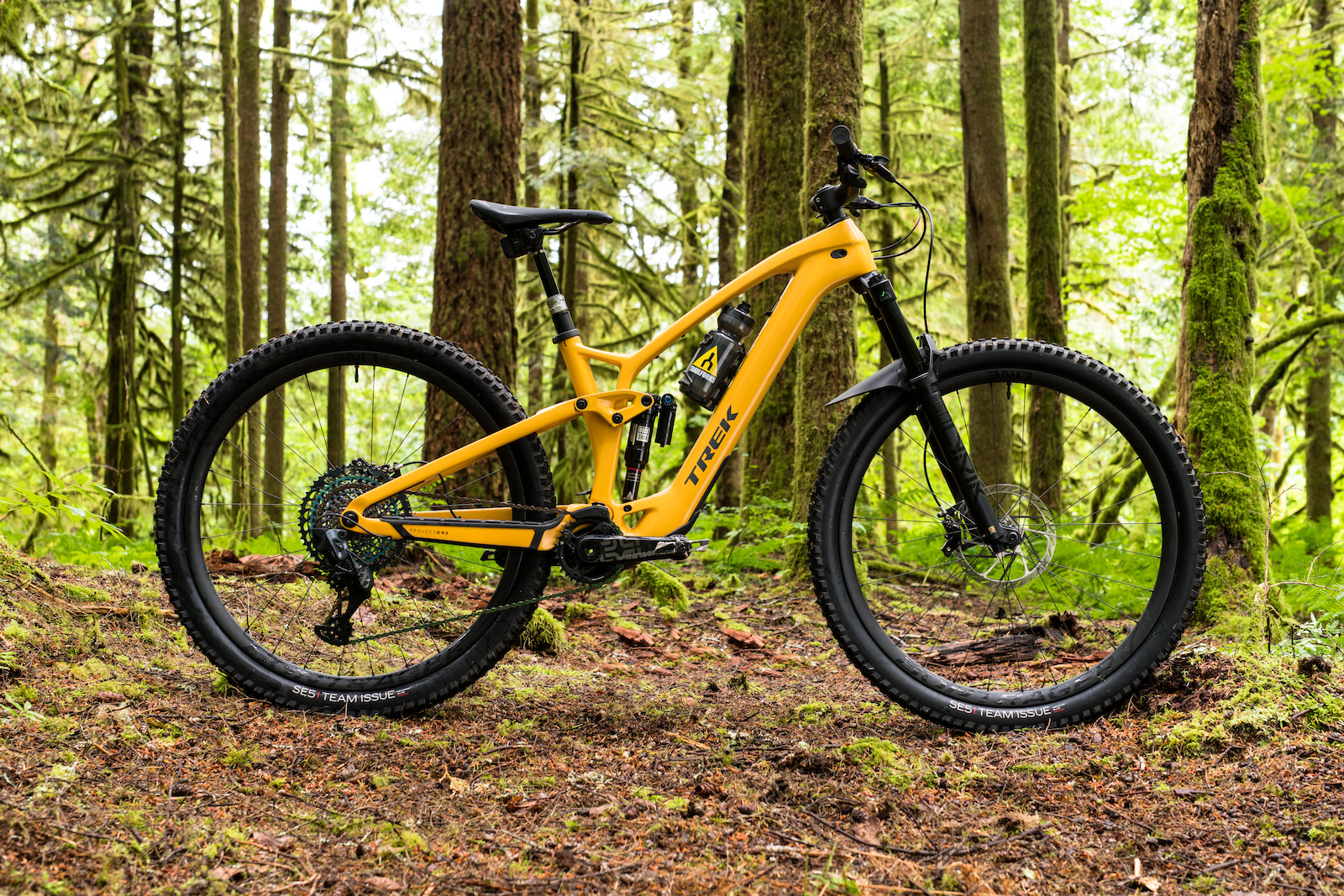
Cool Features
- Mobile Site
- Staff Directory
- Advertise with Ars
Filter by topic
- Biz & IT
- Gaming & Culture
Front page layout
Trail time —
I am superman: the trek fuel exe mountain e-bike, reviewed, hitting the trails with trek's top-of-the-line mountain e-bike, the fuel exe 9.9 xx1 axs..
Sheldon Waite - Dec 17, 2022 12:07 pm UTC
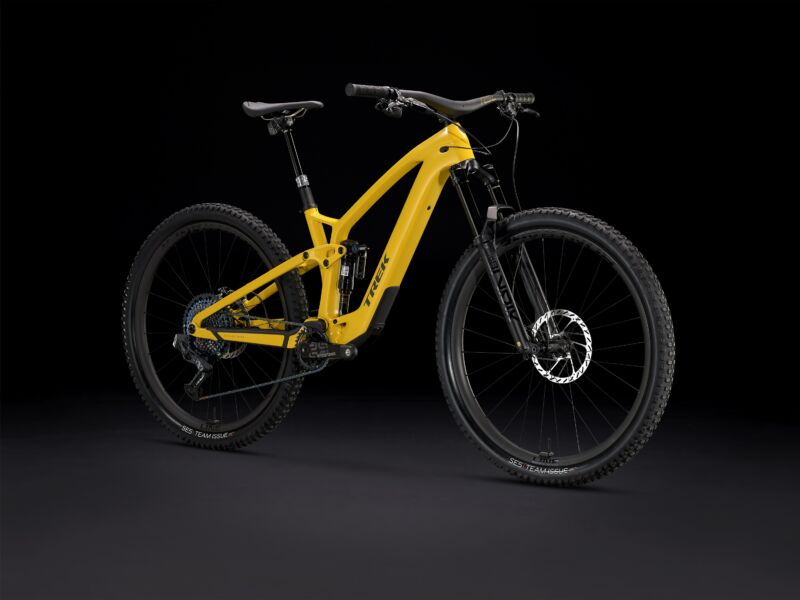
I rediscovered my bike after a few weeks in lockdown. At first, I just pedaled my cheap, steel-framed bike around the neighborhood. After a few rides, it dawned on me that this was a mountain bike! So I took it to my closest trail.
That first exhilarating ride is forever etched into my memory. The early morning sun breaking between the trees as deer darted away, the sound of tires on packed earth, and the stupid grin on my face as I rode fast, flirting at the edge of disaster—or at least pain—with my inexperience on trails. I was hooked to the point of riding the bike into the ground, taking a perverse pleasure every time something broke and I upgraded it. I eventually upgraded to a Trek Fuel EX 7 , and I love it.
The Fuel EX is Trek’s full-suspension trail mountain bike family intended for various terrains, from flowy to techie. Like every model in Trek's lineup, it comes in a large range of trim levels, including aluminum and carbon frames. (My EX 7 has an alloy frame.)
Currently, the EXe version is only available for the highest-specced 9.x bikes with carbon frames, but it is hoped that there will be an aluminum frame option in the near future.
- Trek’s rich gearhead history displayed at its corporate offices in Waterloo, Wis. Sheldon Waite
- Trek owns miles of fun, flowy trails that it uses to test bikes and as a perk for employees to use. Sheldon Waite
Getting my hands on the Fuel EXe 9.9 XX1 AXS involved a two-hour drive to Trek HQ in Waterloo, Wisconsin. There, I not only had a chance to speak with members of the team that developed the Trek Fuel EXe, I also got to ride Trek's private trails.
With the Fuel Exe, Trek is targeting the single-track mountain biker who rides for fun, fitness, and the outdoor experience. To achieve the look, feel, and even sound of a traditional mountain bike, Trek partnered with German technology company TQ. TQ's patented harmonic pin-ring drive can deliver 50 Nm of torque in a tiny package that fits neatly behind the chainring.
The motor offers this torque at a low RPM as it achieves a large gear reduction in a single step. Its movement is akin to a Wankel rotary engine. With the battery pack hiding in the down tube and minimalistic controls, the entire battery-motor combo adds just 8.6 lbs to the weight—an impressively low-weight addition in exchange for some real power. My EX 7 weighs just under 32 lb; the EXe comes in at 38.5 lb. Pedal assist tops out at 20 mph.
The electronic features are well-integrated into the EXe. The display is simple and easy to read at a quick glance while on the trail. Its handlebar controls are simple and intuitive, while allowing for quick cycling between the three assist modes, Eco, Mid, and High.
Customization is done through Trek's new phone app, which offers customization of the three e-bike modes by tailoring max power, assist level, and pedal response. The app defaults for these modes shift each up through Eco, Mid, High. A couple of weeks into my time with the EXe, I tweaked the Mid settings to give me all the power with a mid-high assist, but in a gradual and controlled way. With these settings, I found my ride experience to mimic my analog bike very closely—just easier.
reader comments
Channel ars technica.
- MAGAZINE OFFERS
- BIKE INSURANCE
- Best Products
- Maintenance
- Accessories
- Long-Term Reviews
- BikeRadar Podcast
- First Look Friday
- Bike of the Week
- Tech Features
- Routes and Rides
- Bike Galleries
- BikeRadar Bargains
- Buyer's Guides
- Fitness & Training
- Sizing & Fit
- Mountain Biking UK
- Cycling Plus
Trek Fuel 70(SG) review
Trek's successful Fuel design has been around for a few years, spawning longer-travel offshoots as well as high end cross-country race machines. The Fuel 70 is true to its roots,
Trek's successful Fuel design has been around for a few years, spawning longer-travel offshoots as well as high end cross-country race machines. The Fuel 70 is true to its roots, offering a modest 76mm (3in) of rear travel in a package designed to appeal to cash-conscious trail riders and entry-level racers.
The chassis
The combination of a conventional looking, conservatively designed front triangle and swing arm mated to a rocker-activated, vertically mounted shock gives the Fuel 70 cleaner lines than many of its competitors. The frame detailing and finish is also impressive for the price. The cross-ovalised down tube features a shock mount near its junction with the bottom bracket and a strengthening gusset up front, left open-ended to properly disperse stress away from this critical frame joint in the event of a heavy impact.
The swing arm is an exercise in minimalist engineering. An asymmetric pivot sits in line with the middle chainring for minimal pedal feedback, and at the top of the seatstays a beefy yoke connects to the rocker linkage that drives the RockShox BAR air shock. Most bikes using rocker activated shock designs incorporate an extra pivot near the rear axle, on the chainstays or the seatstays, to allow for the small degree of movement between the two as the suspension moves through its travel. Trek's pivotless design shouldn't, in theory, work as well, but in practice it's never been a problem, and there's a lot to be said for reducing the number of moving parts.
Up front there's a 100mm (4in) travel RockShox J2 fork with adjustable preload, rebound damping and lockout. It works reasonably well in conjunction with the air shock, although - in common with the Saracen and Claud Butler - it lacks the superbly balanced front-to-rear feel of the Mongoose. Coil spring preload adjustment on a fork is always a compromise, and it's only heavier riders who are likely to feel any benefit t. As for the air shock, we felt that the stock rebound damping was set a little too high on our sample bike and - unlike the Saracen - the Trek doesn't offer any adjustment.
Most of the Fuel 70's finishing kit - right down to tyres and rims - carries the name of Trek's in-house design guru, Keith Bontrager. It's all quality stuff with typically good attention to detail, like long saddle rails for plenty of fore-and-aft adjustment and a big stack of washers under the stem to enable you to change the height of the handlebar.
The Shimano Alivio chainset and low-end SRAM SX4 shifters don't quite mesh with the quality feel of the rest of the bike, but it's the brakes that are the biggest let-down. While there's nothing wrong with Shimano's cable-driven discs in the dry, the resin pads have a mayfly-like lifespan in typically wet and gritty British riding conditions. We had to stop halfway down a long descent to adjust the pad clearance, and by the bottom the levers were touching the bar again. Worse still, the discs aren't compatible with harder-wearing sintered pads, so an upgrade is neither simple nor particularly cheap.
With its understated looks and elegantly simple design, the Trek Fuel 70 is likely to appeal to riders who are interested in clocking up the miles rather than looking for a gravity-assisted adrenaline rush. And by the standards of an industry which is besotted with hardcore riding imagery, that's a relatively modest - but entirely worthwhile - goal. It's also one that the Trek Fuel 70 very largely achieves, and with surprising aplomb too, considering the price.
Although the Fuel 70 is no featherweight racer, the combination of careful component choice, a suspension design that's relatively bob-free and a riding position that combines both comfort and efficiency, makes for a solidly reassuring all-day riding companion.
The ride is more hardtail-like than some of its competitors, sacrificing some suppleness on technical climbs and over high frequency trail chatter for a taut, snappy feel that many riders will appreciate. It doesn't have the big-hit ability of the Mongoose and it's not quite as fluid through fast, choppy sections as the Saracen, but this 'connectedness' with the ground is more a difference in approach than a downside. The well sorted geometry contributes to the bike's lively, intuitive handling that will flatter any rider's skills, from beginner to hardened trail warrior.
If it weren't for the awful wet-weather durability of the brake pads, it would be easier to give the Fuel 70 a resounding thumbs up for keen trail riders and entry-level racers who are looking to upgrade from a hardtail. But as it is, unless your riding is confined to dry conditions, you'll be swapping the pads and discs for something more durable very quickly.
Share this article

- Terms & Conditions
- Subscribe to our magazines
- Manage preferences
Trek Fuel EX 8 review – still one of the best trail MTBs?
Trek’s alloy fuel ex trail mountain bike lacks the latest features but is the overall package still a winner.

BikePerfect Verdict
Heavy frame that misses the latest features but still a great package for fast and precise all round mountain biking
Tight, precise frame
Sorted all round handling
Very efficient suspension feel
Durable Shimano kit
Excellent sizing options
Heavy frame
No internal storage
Press fit bottom bracket
Top Fuel is more playful
Why trust BikePerfect Our cycling experts have decades of testing experience. We'll always share our unbiased opinions on bikes and gear. Find out more about how we test.
Trek’s Fuel EX has been one of the best mountain bikes in the world for years, but the alloy-framed 8 is lacking some of the features the latest alloy and carbon Treks. High-durability component spec matches the vibe of a really well-balanced bike. One that plans ahead, hands its homework in early (having double checked it) and rarely puts a wheel wrong or goads you into being silly yourself. So how has Trek done that and is there a better option in the range if you want something short on travel but big on fun?
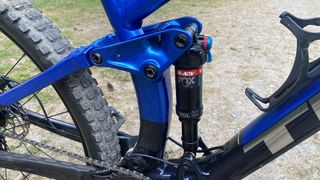
Design and aesthetics
Trek has been using a rocker link-driven, vertical shock suspension design on its bikes for so long that “Looks like a Trek Session” is a cliche on most MTB forums. No surprise then that the Fuel EX continues the clean looks which leave plenty of room for a big bottle on the down tube and strap-on storage. You don’t get the internal storage of the newer Top Fuel alloy frame though and this older frame still uses a press-fit bottom bracket rather than reverting to a more reliable threaded format. There are ISCG chain keeper tabs on the BB though, a wider-angle Knock Block steering limiter to stop bars hitting the frame in a crash and rear axle concentric ABP rear suspension pivot. Cunning zip tie tabbed ‘Control Freak’ internal cable routing and rubber frame armor including molded chainstay sleeves keep things quiet.
You also get the 0.5-degree geometry change ‘Mino Link’ flip chip at the seat stay/rocker pivot. That changes head angle from 65.5- to 65-degrees and effective seat angle from 75.5- to 75-degrees on the Large I tested. Reach also shifts from 475 to 470mm and BB height drops from 346 to 340mm. The big win with choosing a Trek though is the sheer range of sizes from XXS to XXL including a sweet spot ML in the centre. Smaller bikes also run 27.5in wheels for proportional balance, too, although the chainstays are the same length on all frame sizes. The Fuel EX 8 is also available in three different two-tone color options.

Specification
Trek acknowledges that the ‘priority is on the parts’ with the EX 8 and the highlight is an almost complete Shimano XT drivetrain (the chain is SLX). The Fox Float shock is a custom unit, too, using a Penske race car derived RE:aktiv damper setup for a pert-pedaling feel on top of the 130mm travel. The 140mm Fox 34 fork is the stock Rhythm spec though and the Shimano brakes are basic four-piston MT400s. Bontrager’s functional Line component range completes the bike in well-judged, size-specific cockpit options although dropper post strokes are short on the larger sizes. Big volume versions of Bontrager’s XR5 and XR4 tires on Bontrager Line Comp 30mm internal rims put plenty of air between bike and trail for protection, too.
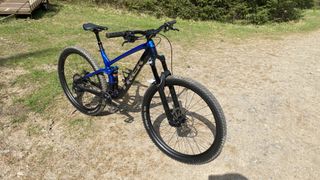
Performance
While the EX8 isn’t light at just under 15kg (a full kilo heavier than Trek claims) it’s in the ballpark for a mid-travel, alloy-framed bike at this price. What really stands out is how well it hides that weight when it comes to pedaling. The big tires don’t drag nearly as much as they look like they might, while the RE:aktiv shock and overall kinematic give it a really clean, crisp and stable platform to put down power from. That means even with three potential low-compression settings to play with, we rarely felt compelled to flick it out of full open unless we were hoofing uphill out of the saddle. Add the clean shifting, top-quality Shimano XT drivetrain and the Fuel EX is a great choice for high-mileage rides and riders. The fast-engaging ‘Rapid Drive’ freehub and relatively high ground clearance are a bonus for anyone who likes to kick hard out of corners or attack rough technical climbs, too. The efficient suspension feel still gives enough sensitivity to track the ground under power and you can drop pressures in the big tires if you’re into a proper ‘crawler/swamper’ feel.
The 140mm fork/130mm rear travel feels well balanced on the trail and the Grip damper Fox Rhythm repeatedly proved why its our favorite cost-effective fork. Trek’s suspension calculator is accurate enough to get most people sorted on set-up for most situations. The angles and proportions of the model we tested were confident at speed on jumps but still turned in promptly on woodland twisters. Even the basic Shimano brakes feel better than normal through the neutral suspension responses created by the ABP pivot and the 200mm rotor up front boosts power, too.
While you could speed up reactions with a shorter stem, the stock setup probably suits its overall character better. That’s because while it will pop and play off trailside opportunities if you’re in the mood, it does tend to sit on top of an already relatively high ride height rather than sucking down onto the trail and railing. Interestingly that’s a big - and counter intuitive - difference to the Top Fuel 8. With slightly steeper angles, less travel, significantly different suspension kinematic and top-spec RockShox rear shock, Trek’s pocket rocket has an addictively playful charisma that’s very much at odds with it’s ‘XC’ categorization.
In fact, despite it being heavier we’d probably opt for the Fuel EX for long marathon-style or efficiency-based events, especially as it’s significantly cheaper than its little brother, leaving you more cash for race entries and energy products. Just make sure you keep an eye on the press-fit bottom bracket and get it replaced as soon as it shows any signs of wobble/creak as that can eventually creates frame issues.
Trek’s Fuel range might be a bit backwards when it comes to assigning categories based on travel but the main thing is that the Fuel EX is still a really efficient, enjoyable and fitness/skill flattering all rounder. While it misses out on the internal storage, threaded BB and super-plush playfulness of the Top Fuel, Shimano XT will always bring a lot of hard riding boys (and girls) to the yard. Those are exactly the riders who’ll appreciate just how well this extremely well balanced bike covers ground and keeps a fresh and sharp feel long into the day, and down tough technical sections, too.
Tech Specs: Trek Fuel EX 8 XT
- Price: $3,929.99 / £3,200
- Discipline: Trail
- Head angle: 66/66.5-degrees
- Frame material: Trek Alpha Platinum Aluminum
- Sizes: XS, S, M, M/L, L (tested) XL, XXL
- Weight: 14.9kg
- Wheel size: 29 x 2.3in
- Suspension (front/rear): Fox Rhythm 34, Float EVOL 140mm travel, 44mm offset/Fox Performance Float EVOL, 3-position RE:aktiv 130mm travel
- Components: Shimano XT 10-51T, 12-speed gearing, shifter, chainset and cassette. Shimano SLX chain. Shimano MT400 brakes with 200/180mm rotors. Bontrager XR4 Team Issue 29 x 2.6in front and Bontrager XR5 Team Issue 29 x 2.5in rear tires on Bontrager Line Comp 30 wheels. Bontrager Line 780 x 35mm bar and 50 x 35 mm stem, Bontrager Line Dropper 150mm dropper post, Bontrager Arvada saddle

Guy has been working on Bike Perfect since we launched in 2019. Hatched in Yorkshire he's been hardened by riding round it in all weathers since he was a kid. He spent a few years working in bike shops and warehouses before starting writing and testing for bike mags in 1996. Since then he’s written several million words about several thousand test bikes and a ridiculous amount of riding gear. To make sure he rarely sleeps and to fund his custom tandem habit, he’s also penned a handful of bike-related books and talks to a GoPro for YouTube, too.
Current rides: Cervelo ZFS-5, Forbidden Druid V2, Specialized Chisel, custom Nicolai enduro tandem, Landescape/Swallow custom gravel tandem
Height: 180cm
Weight: 69kg
- Guy Kesteven Technical-Editor-at-Large
Canyon unveil its lightest electric mountain bike ever – the Neuron:ONfly
Canyon Strive:ON CFR review – a UCI EDR-E championship-winning, carbon, full-fat enduro e-bike
Is Rotor's Kapic crankset and oval Q Ring setup pedaling perfection, or did it leave me riding all out of shape?
Most Popular
- Fuel EX 7 Gen 5

- Cycling Magazine
A tale of two Treks: Fuel EX vs Fuel EXe
Comparing electric and traditional models of the same bike.
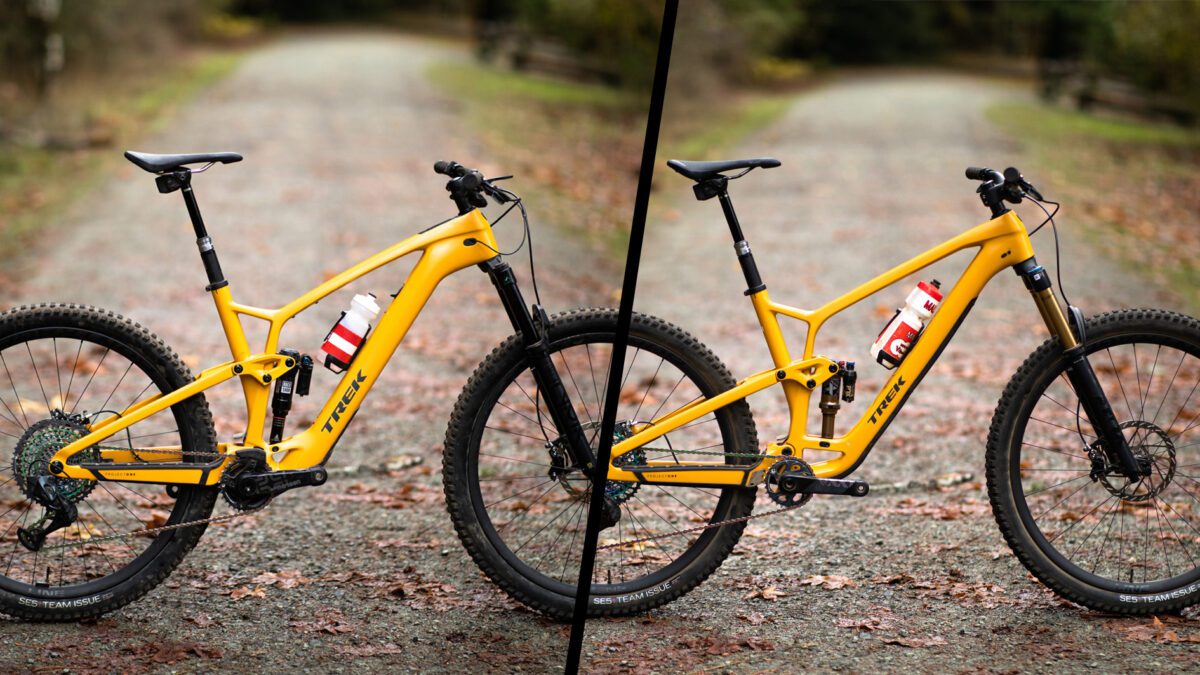
When Trek released the Fuel EXe and Fuel EX just weeks apart the similarities were obvious and intentional. The sixth generation of Trek’s Fuel EX looked much different than previous years. But it was almost identical to the look of Trek’s new lightweight eMTB, the Fuel EXe.
That the two bikes look so similar is a testament to what Trek achieved with EXe by using TQ’s new HP150 motor. Other than a slightly larger downtube on the EXe, it can be hard to tell the bikes apart at a glance.
RELATED: Long-term review: Trek Fuel EXe shifts the standard for eMTB
The similarities don’t stop at appearance, though. Trek wants the Fuel EXe to ride like its traditionally-powered partner, the EX. After several months of riding both brand-new Treks, we put the two bright yellow steeds head-to-head to see how they compare.
Trek Fuel EX vs Trek Fuel EXe
By the numbers: Trek Fuel EX vs. Trek Fuel EXe
While the two Treks look similar, down to the bright yellow colour, there are differences in the details that go beyond just the presence or absence of a motor. While both have Trek’s Mino Link, the Fuel EX has a storage compartment in the downtube and more adjustment, including the ability to adjust head angles with headset cups and suspension progression via a flip chip at the shock mount.
Here’s how the two Treks compare, by the numbers.
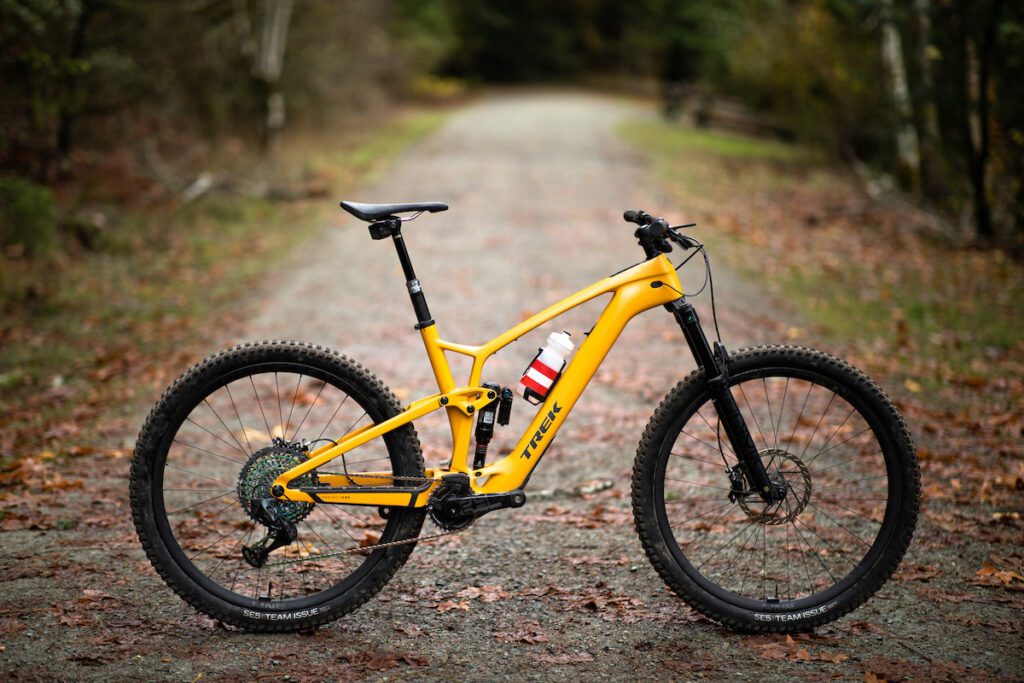

2023 Trek Fuel EXe 9.9 AXS

An extra "e" makes all the difference

TQs black and white display
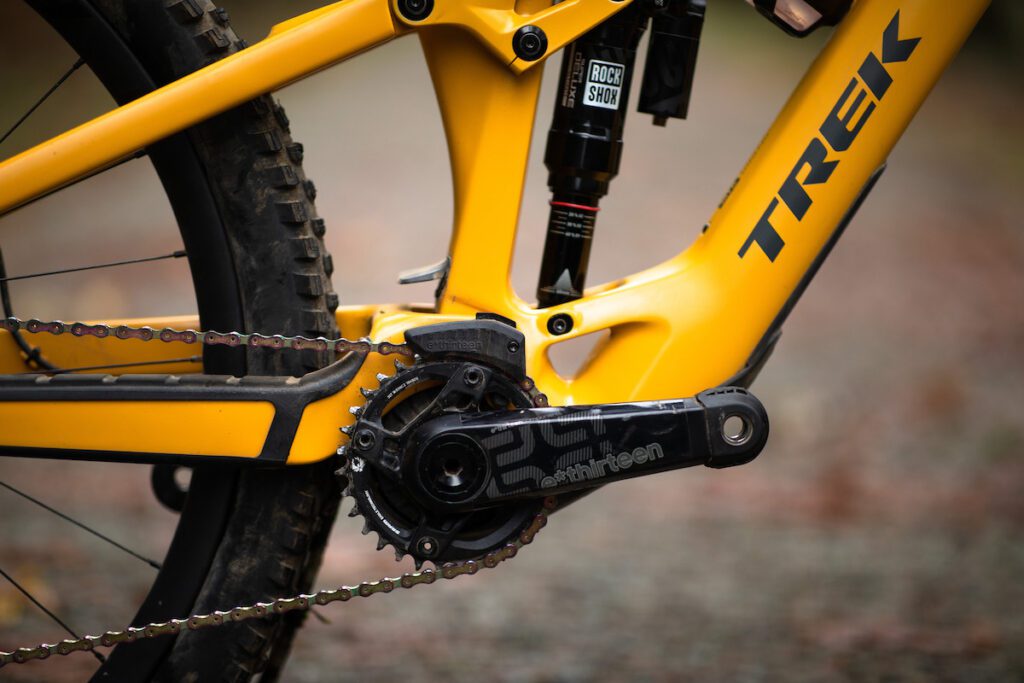
Controls the TQ HPR 50 hiding behind the cranks
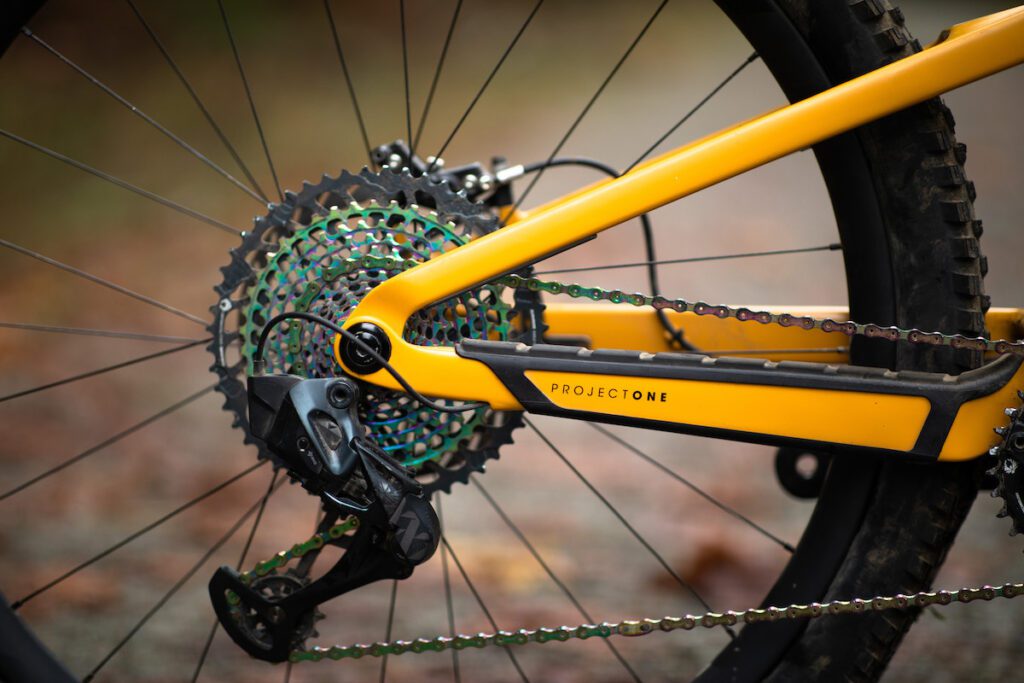
Trek Fuel EXe with hard-wired SRAM AXS wireless shifting

Trek Fuel EXe 9.9 xx1 AXS
Weight: 18.45 kg. (40.6 lbs) Frame material: carbon fibre Travel: 140mm rear, 150mm front Motor: TQ HPR 50 Battery: 360 Wh battery Geometry adjustments: Mino Link Wheels: 29″ (with option to run 27.5″ rear wheel) Sizes: S, M, L, XL Price: $18,300
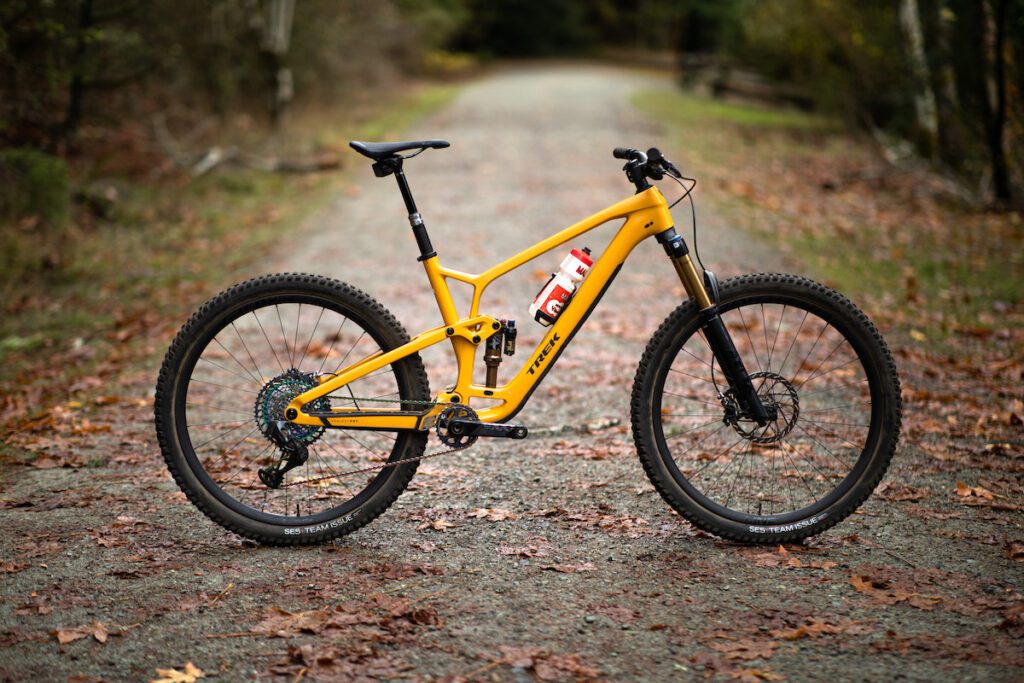
2023 Trek Fuel EX 9.9 AXS

Fuel EX, with a downtube storage compartment hiding below the water bottle cage
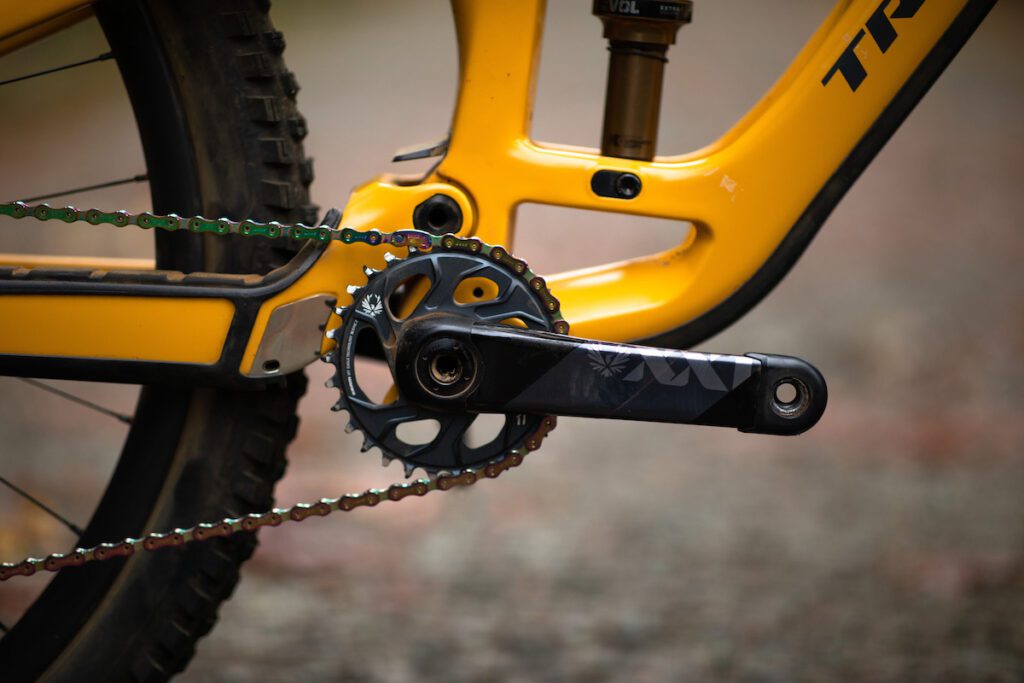
Trek also allows a 27.5" rear wheel
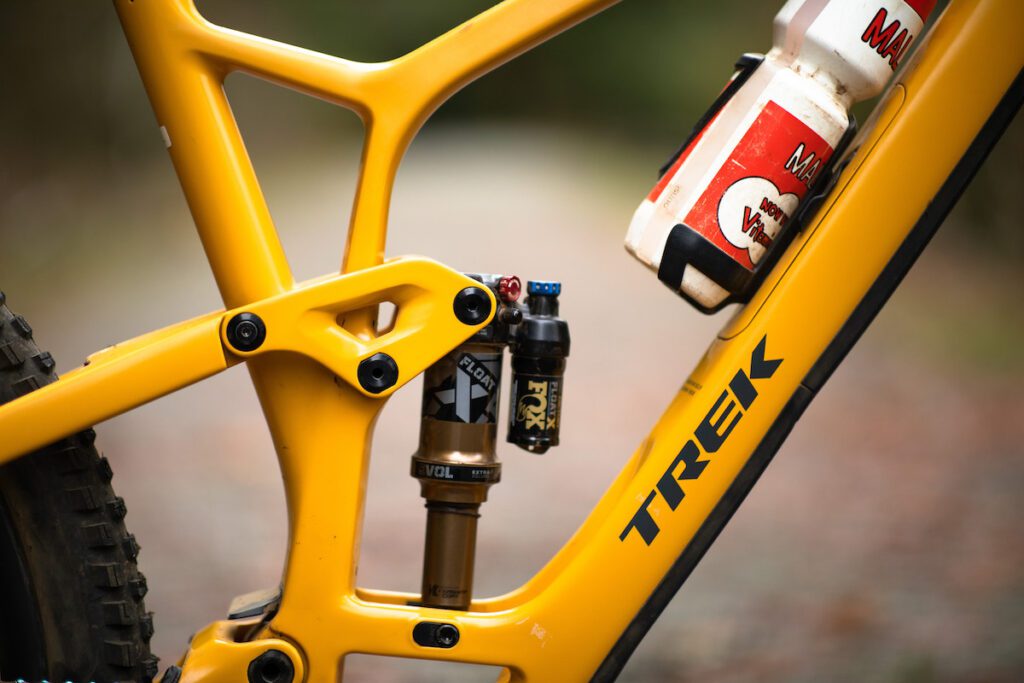
A flip-chip where the Fox shock attaches to the frame changes the Fuel's suspension progression

All AXS, no wires for the Fuel EX

Trek Fuel EX 9.9 XX1 AXS (Gen 6)
Weight: 14.11kg (31.11lbs) Frame material: carbon fibre Travel: 140mm rear, 150mm front Geometry adjustments: Mino Link, Head tube angle, suspension progression Wheels: 27.5″ in XS-S, 29″ in S-XL (with option to run 27.5″ rear wheel) Sizes: XS, S (27.5″), S (29″), M, M/L, L, XL Price: $13,700
One last difference is frame material. Trek offers the Fuel EXe in six models, all with carbon fiber frames. The most affordable is the EXe 9.5, at $8,400. The Fuel EX, on the other hand, is available in carbon fiber and aluminum frames. There are eight Gen 6 Fuel EX builds, with the EX 7 coming in at just $4,400. So, while both top-end bikes are made of carbon fiber, there is a wider range of price points with the Fuel EX.
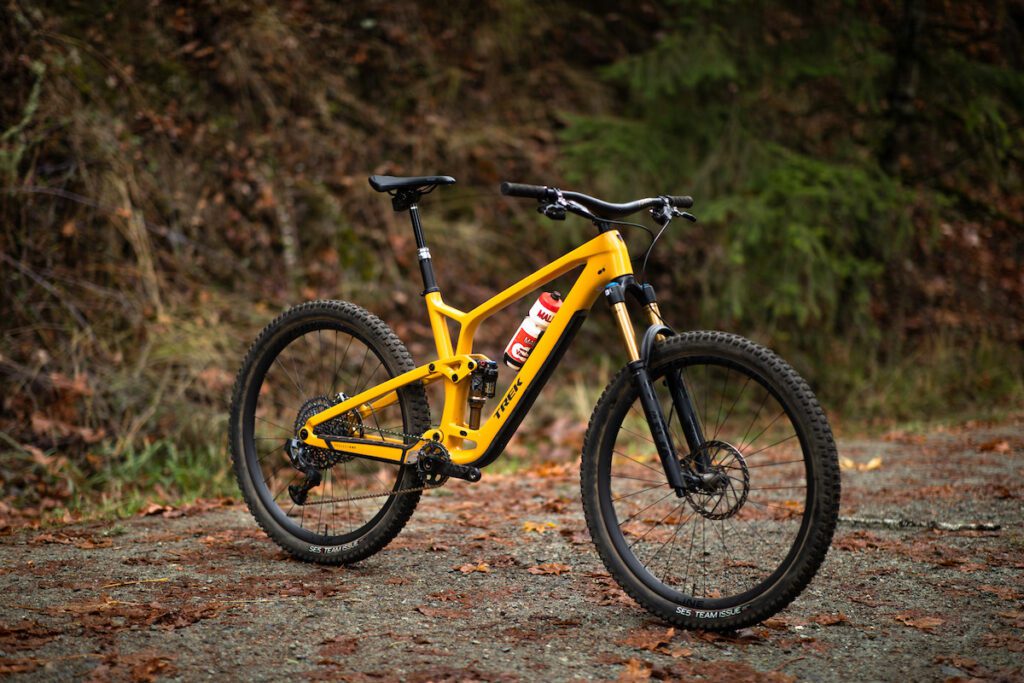
Trek Fuel EX

Trek Fuel EXe
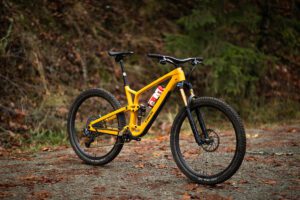
How do you want to Fuel your ride?
While there are other eMTB that share the same name as their pedal powered cousins, it is distinctive, if not unique, to have two bikes this close in design. Trek clearly wants the EXe riders to have as close to the analog experience as possible. With the help of TQ’s motor, the EXe gets closer to the feeling of analog than the vast majority of other e-mountain bikes.
For traditional riders thinking of going electric, the EXe offers an option that is familiar to what they already know. With the two bikes sharing the bulk of their design, it really is very easy to go back and forth between the two bikes. Owning both 9.9 models would be a fabulously expensive prospect but, for riders looking to own an eMTB and traditional bike, moving down the Fuel EX lines gets more affordable.
Trek has created two impressive bikes. Both are very capable, and very fun trail bikes to ride. While the TQ motor is light, removing it obviously makes the Fuel EX feel a bit more dynamic on the trail. The Fuel EXe , with motor, comes with the obvious advantage of more power. What stands out, though, is how close the bikes are to each other.

- Email address: *
- Phone This field is for validation purposes and should be left unchanged.
4 upgrades & 7 updates on our Fuel EXe long-term test bike | Trek Fuel EXe Review
The not-so-minor details.
2023 Trek Fuel EXe
https://www.trekbikes.com
$9,499 AUD - $12,999 AUD
The Trek Fuel EXe was launched just a few months ago, arriving to much fanfare thanks to its unique TQ-HPR50 motor and clean aesthetics. We were totally captivated by the smooth and quiet motor performance, while the low weight, balanced geometry and supportive suspension gave it an impressively playful and agile character on the trail.
We’ve since spent a load more time aboard our test bike, and have made a few key changes and upgrades along the way. For those who are curious about this lightweight e-MTB, or for those who already own one and are looking to delve a bit deeper into its capabilities, here’s a look at what we’ve learned from our long-term review of the Trek Fuel EXe.
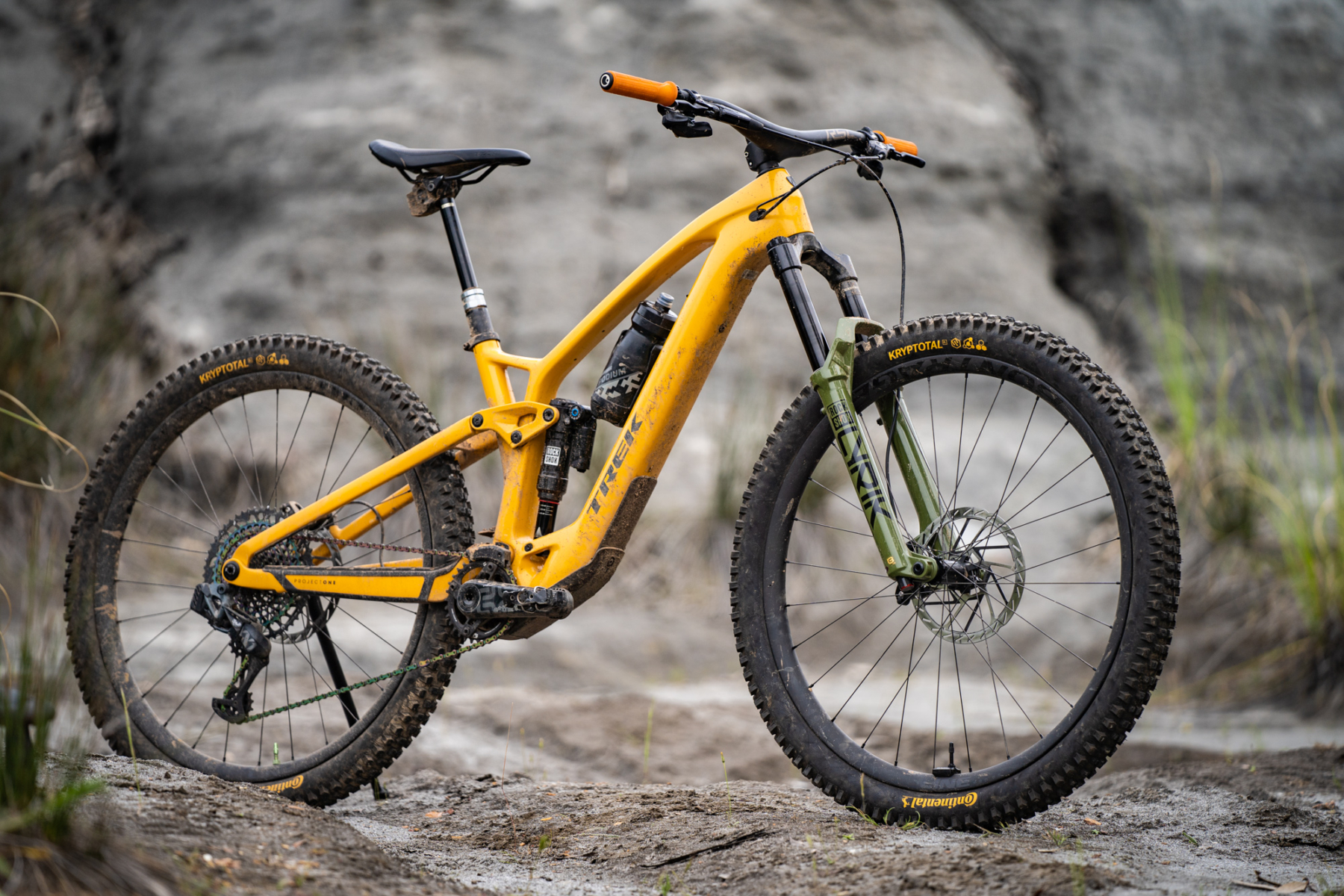
There’s an app for that
The release of the Fuel EXe has been accompanied by a new app called Trek Central.
Designed specifically for the Fuel EXe, the app incorporates a number of features including ride tracking, navigation and range estimation. It allows you to tune the performance of the TQ HPR50 motor, and it provides recommendations on suspension and tyre setup. You can pair the app with a heart rate monitor, and it’ll even talk to SRAM TyreWiz and AirWiz modules to provide live pressure readouts.
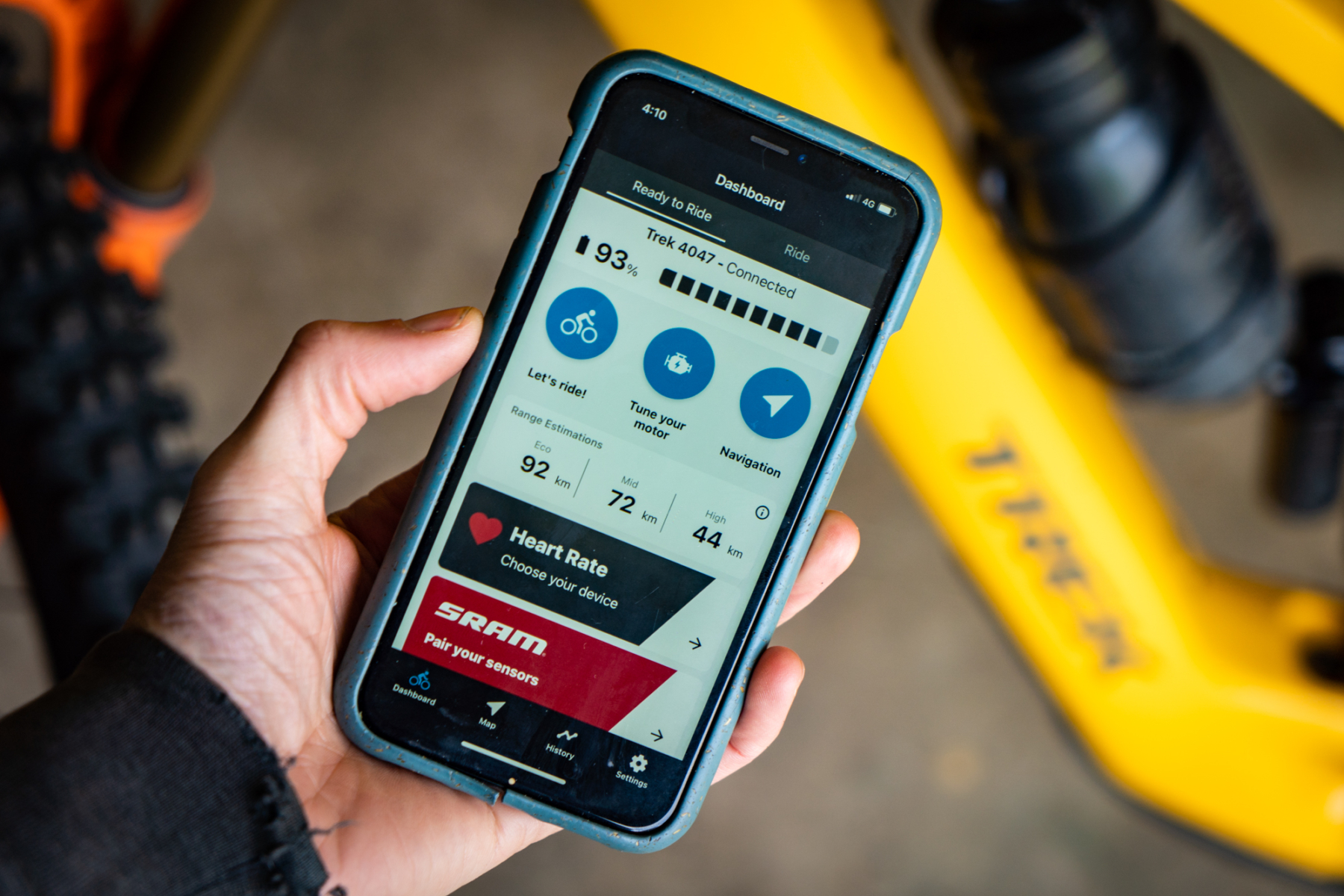
It’s easy to tune the TQ-HPR50 motor
The most interesting component of the Trek Central app is the Perfect Tune function. This lets you adjust the motor’s power output and assistance behaviour across each of the Eco, Mid and High assist modes. Within each mode you can adjust the Maximum Power, Assist Factor and Pedal Response using a simple sliding scale.
Our main interest here was to see if we could give the TQ motor a little more punch for shorter rides. Although the High mode already comes with the Maximum Power set to the full 300W, it is possible to increase both the Assist Factor and Pedal Response settings, which is exactly what we did.
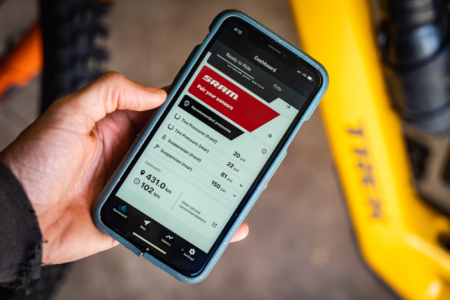
With both settings maxed out, the Fuel EXe accelerates faster and requires less pedal input to deliver maximum power. It still requires plenty of input, and it isn’t as gutsy as a full-powered motor like a Bosch Performance Line CX or Shimano EP8, but it is noticeably quicker compared to the stock settings.
Of course the downside is reduced range, and it’s possible to rinse that 360Wh battery pretty quickly, especially for heavier riders. It works well for an hour-of-power session after work, but for longer rides you’ll want to make use of the Eco and Mid settings, and consider dialling down the Assist Factor. This will encourage you to pedal harder to receive maximum motor support, while only relying on the High setting when you really need it.
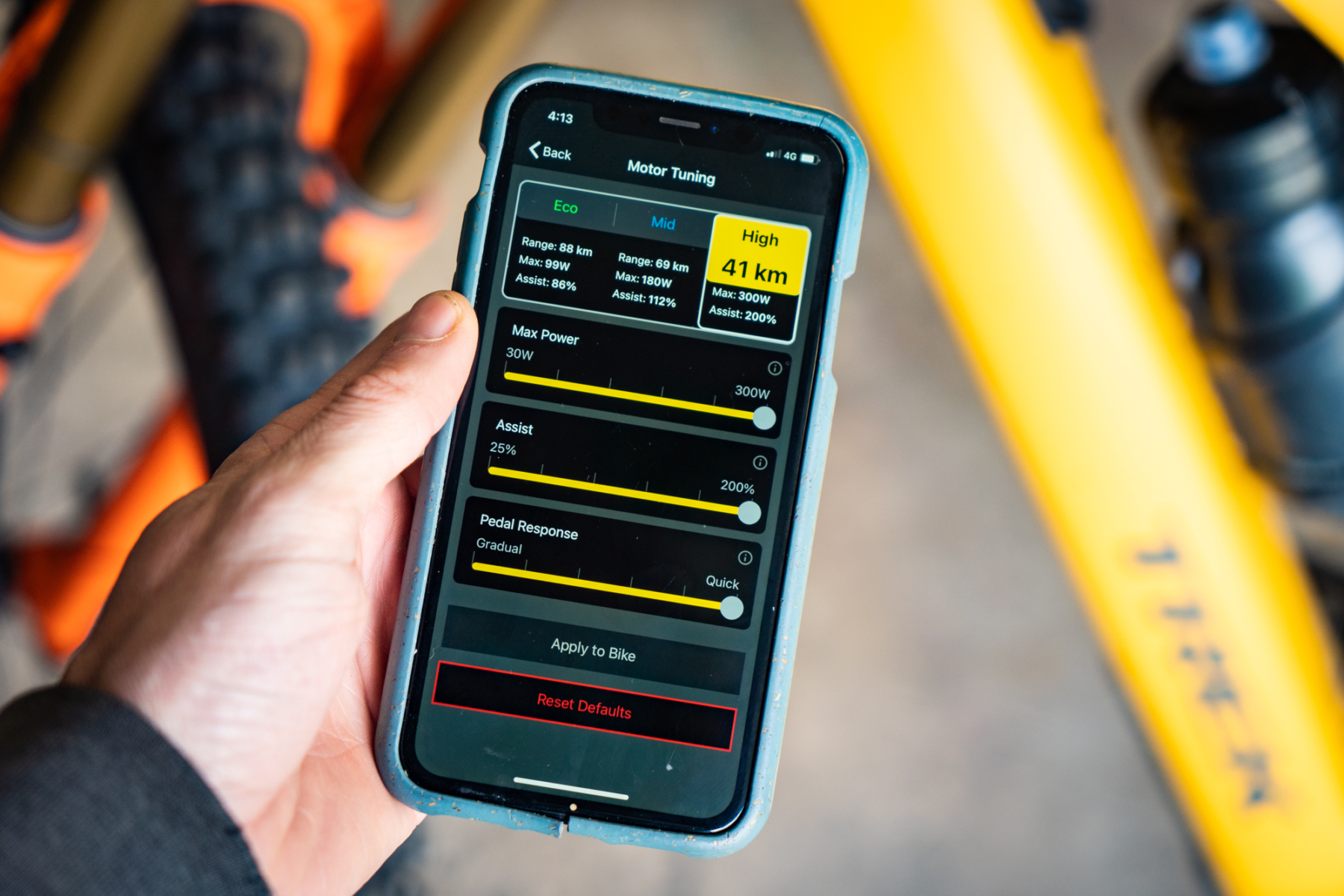
It still has some lag
In our initial review, we mentioned that the TQ-HPR50 motor didn’t always provide support when we wanted, exhibiting some lag in certain circumstances.
Now we aren’t referring to the mechanical pickup of the motor. That is near-instantaneous, with very little free-play in the cranks before they engage the drive system. Rather we mean the delay between when you input a pedalling force, to the point that the motor starts delivering power output.
Even with the Pedal Response set to the maximum level, this delay can still sometimes occur. If you’re climbing in a higher gear at a slower cadence, pausing to freewheel over an obstacle won’t be met with instant power delivery once you get back on the gas. Similarly, if you’re cruising along at speed and need to pause on the pedals, there is some lag in the motor’s pickup when you begin pedalling again.
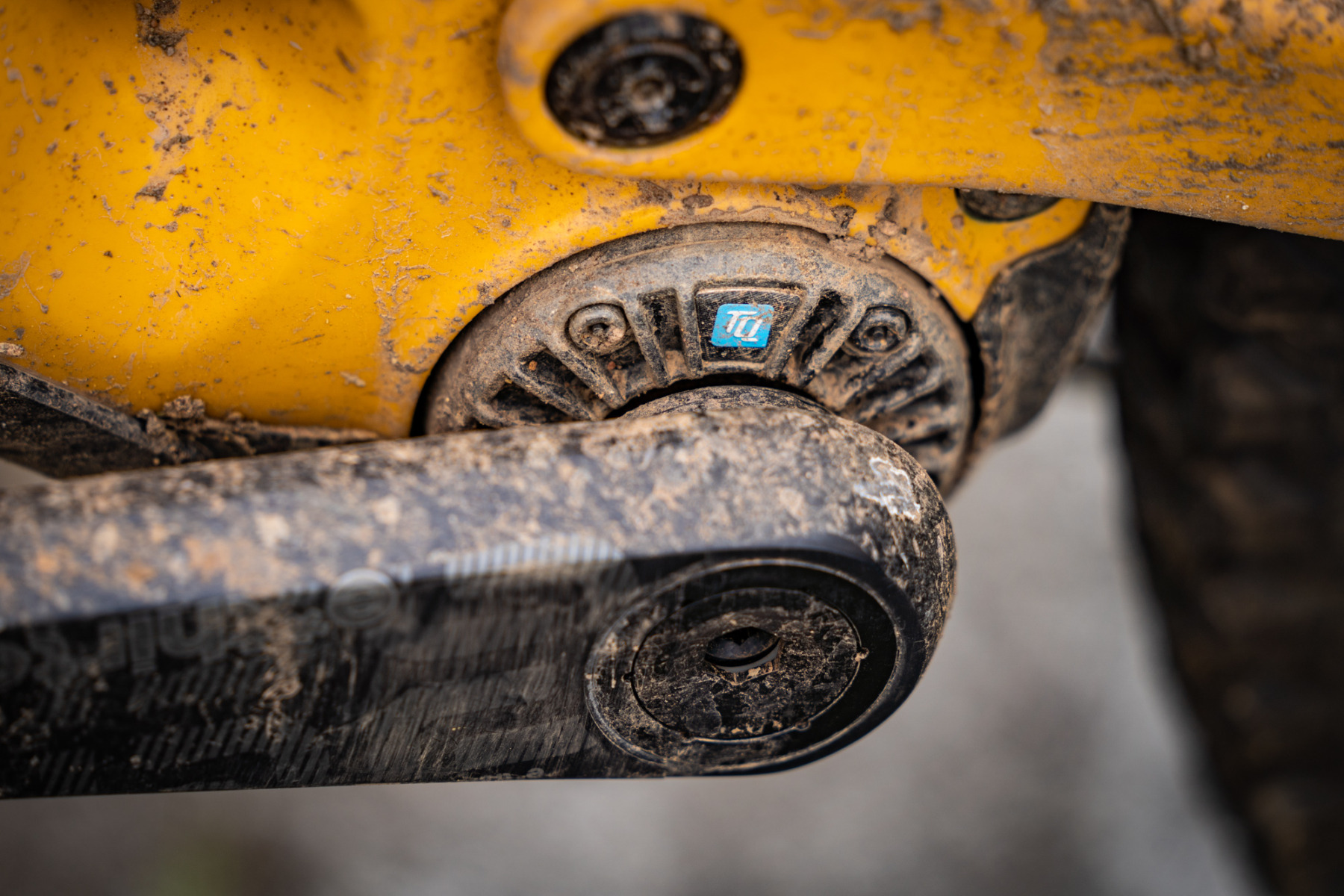
To avoid this, we’ve found the TQ-HPR50 motor to provide better support at higher cadences. Make use of the lower gears, spin at a higher RPM, and the motor will respond faster and more willingly.
Generally speaking though, this is a motor that is here to give you a subtle helping hand rather than feeling like you have a rocket booster strapped to the bike. The soft and smooth power delivery is what contributes to its discreet and energy-efficient performance, allowing the Fuel EXe to be built with such a small and lightweight battery in the first place.
The wide Q-factor may be a bother
Despite spending another couple of months on the Trek Fuel EXe, I’ve not gotten used to its wide stance at the pedals.
To clarify, the TQ-HPR50 is one of, if not the smallest mid-drive motors on the market, and its bottom bracket axle is narrow at 135mm. The issue is with the carbon e*13 crank arms that come on the Fuel EXe 9.8 and 9.9 models. These bulky cranks add significant width to the overall Q-factor, pushing the pedals further away from the bike.
According to my measurements the Q-factor is nearly 195mm. That is very wide, and it’s caused me some knee pain on longer rides.

I visited a local Trek dealer and compared the Q-factor with the alloy e*13 cranks that come on the cheaper Fuel EXe 9.7 and 9.5 models. The difference is almost 20mm, with the alloy crank arms being considerably slimmer and coming much closer to a crankset on a regular mountain bike.
Many riders won’t be fussed by a wide Q-factor, and indeed the broader stance can improve overall stability on the bike. But for riders with sensitive knees, it is something to consider. Indeed if the Fuel EXe were my bike, I’d be looking at changing out the crank arms.
But it’s oh so quiet
Since reviewing the Trek Fuel EXe, I’ve been riding a whole bunch of other e-MTBs including the Canyon Spectral:ON , the Scott Patron and the Cube Stereo Hybrid 160 . Those all make use of full-powered motors that have their various strengths and weaknesses, but one of the most noticeable differences is the amount of noise out on the trail.
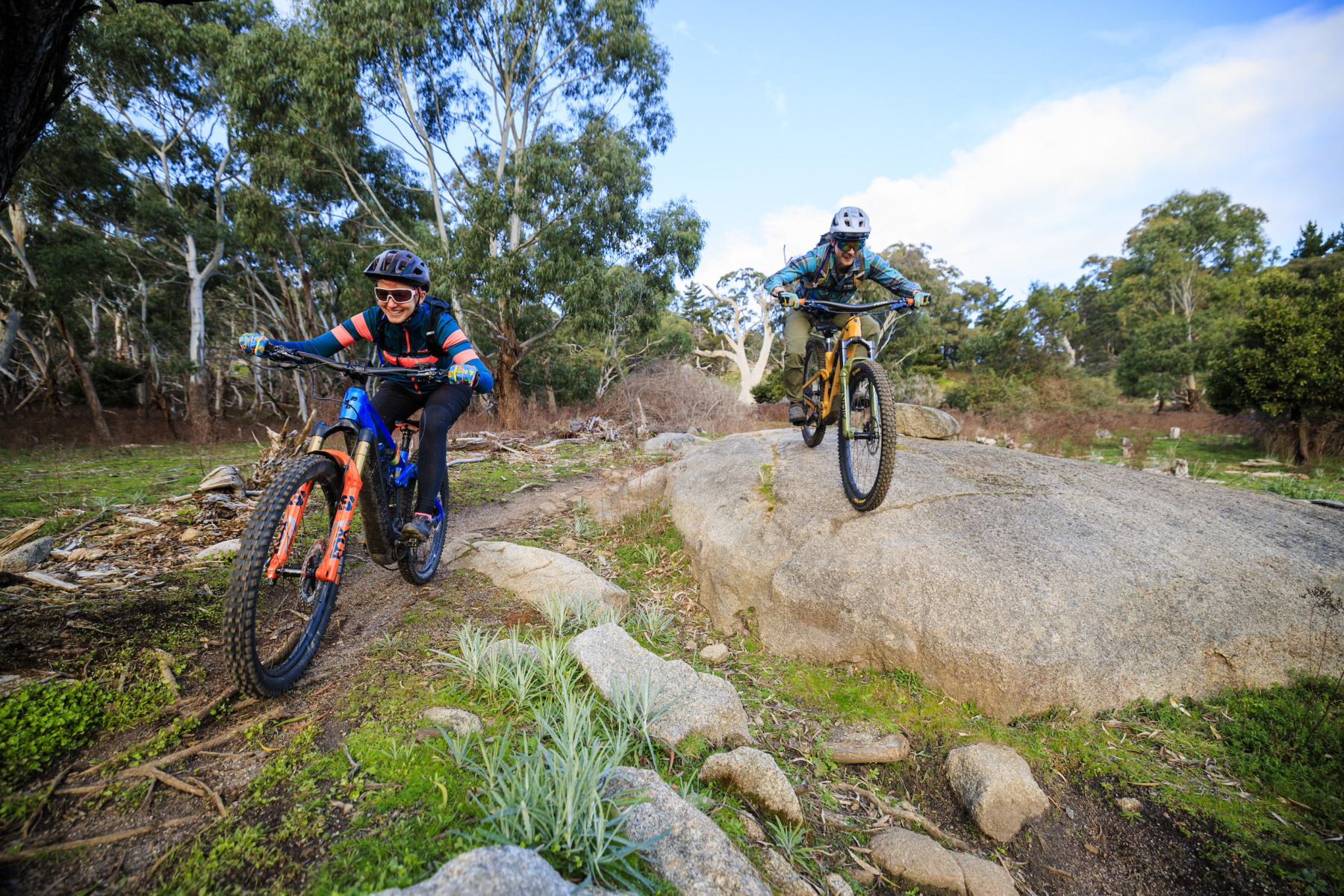
The TQ-HPR50 motor is remarkably quiet, even in the highest assist mode with all of the settings maxed out. The pitch and overall volume are so discreet, that every time I jump onto a full-powered e-MTB, it feels like I’m riding a vacuum cleaner.
It’s also unnoticeable on the descents, with none of the freewheel clacking that has plagued the Shimano EP8 and Bosch Performance CX drive units. Along with its smooth and surge-free power delivery, I’ve been really impressed with the experience that the stealthy TQ motor brings to riding the Fuel EXe, which feels closer to a regular mountain bike than a full-powered e-MTB.
The RockShox suspension is performing beautifully
Both the Trek Fuel EXe 9.8 XT and the top-end 9.9 models come fitted with the new 2023 RockShox forks and shocks as standard. Featuring an all-new construction with updated internals, the Lyrik is equipped with the new Charger 3 damper, and the Super Deluxe shock features the RC2 damper.
In our initial review, we found the Fuel EXe’s suspension to be incredibly supportive, but not the most compliant over smaller bumps. That was particularly the case up front with the Lyrik, which even felt harsh in some situations.
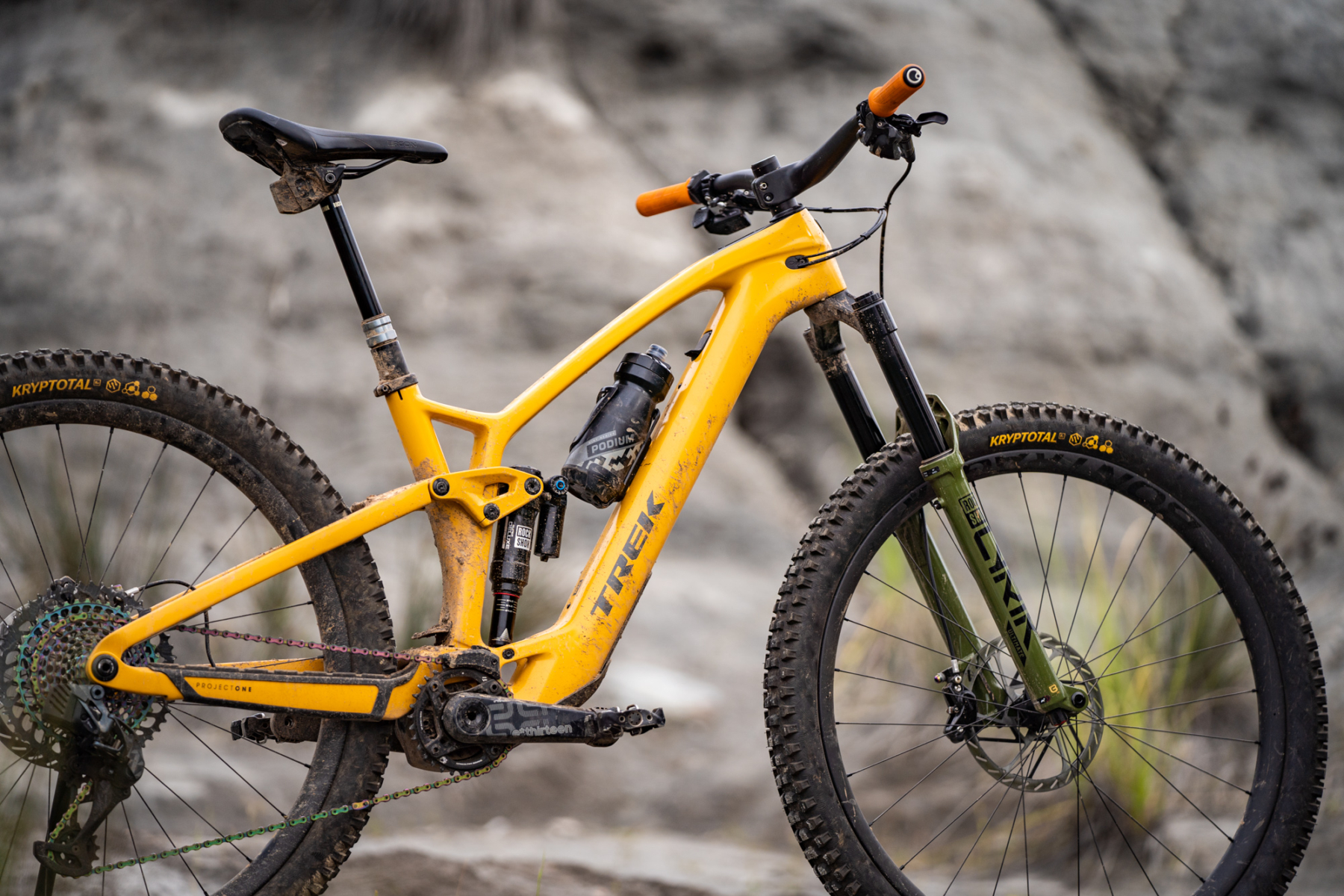
I’m happy to report that the suspension has bedded in a lot since new, though I’ve since been riding the Fuel EXe with a different Lyrik Ultimate. This Lyrik had been freshly serviced by SRAM, and it has bedded in beautifully over the last few weeks of riding. Compared to the original fork it is significantly smoother and plusher, especially across smaller rubble. The support is still there, it’s just vastly more comfortable and reactive.
This experience has turned around my earlier feelings on the Lyrik, which I wasn’t overly impressed with. Aside from the different colour, the only difference between these two forks is the fact that the green one had been serviced. It isn’t uncommon to encounter varying levels of assembly grease and oil with mass-produced suspension products, though perhaps the new RockShox forks are more sensitive to it.
My advice to anyone out there with a 2023 RockShox fork that is feeling harsh? Have your local bike shop check the lowers for the proper lubrication levels. It could make all the difference, as it has done on our Fuel EXe.
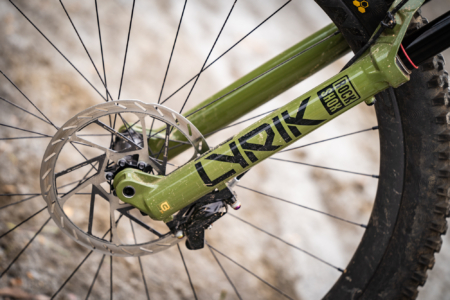
It’s brilliant with a 160mm travel fork
While the Trek Fuel EXe comes standard with a 150mm travel fork, the frame is rated for use with up to a 160mm fork. And so alongside the green Lyrik Ultimate, I’ve also been testing a Fox 36 GRIP2, both set at 160mm of travel.
The extra 10mm of travel does lift up the BB slightly, and it also slackens the angles a touch. With the longer fork fitted, I needed to nose the saddle down slightly, and I dropped the stem down one spacer to bring the grips down to the same level as before.
On the trail the longer fork feels fantastic. There may be a touch more front wheel wander on the climbs, but having lowered the stem to get more weight over the front, it’s pretty minimal. And the added ground clearance has actually improved the Fuel EXe’s technical climbing abilities, allowing me to keep pedalling over chunky sections with less fear of pedal strikes.

It’s on the descents where the extra 10mm of travel has been most welcome though, delivering increased grip and control when things get rough and rowdy. The whole bike feels more planted, and it’s plusher overall.
I was worried the bigger fork might feel mismatched with the 140mm of rear travel, but that hasn’t been the case. The Fuel EXe is a mighty capable bike, and its rear suspension is nice and progressive with plenty of end-stroke support thanks to the Hydraulic Bottom Out feature in the new Super Deluxe shock. Because it uses its travel in such a controlled manner, it actually feels more balanced with the bigger fork up front.
With that in mind, I can highly recommend experimenting with a longer fork on your Fuel EXe. The good news is that this a relatively cheap upgrade, as you only need to buy a 160mm air shaft to extend the RockShox Lyrik and Fox 36.

Mullet compatibility
A lesser known fact about the Trek Fuel EXe is that it can be run as a mullet. While the bike comes standard with 29in wheels and the Mino Link set in the Low position, Trek says flipping the chip into the High position will help counter the drop in BB height if you decide to fit a 27.5in rear wheel.
That’s true to an extent, though the difference in BB height between the High and Low positions is only 7mm. In our experience with trying out mullet conversions on other bikes, that difference isn’t quite enough. If we were to mullet the Fuel EXe, we’d recommend pairing that setup with a 160mm travel fork to help lift the BB up again to roughly the same spot as the stock setup.
The downside of fitting a 27.5in rear wheel? The TQ’s speed sensor can’t be recalibrated for a different wheel circumference, so the system will still assume you have a 29in wheel fitted. This will affect the speed readout on the top tube display, changing the motor’s behaviour slightly and resulting in a lower actual cutoff speed.
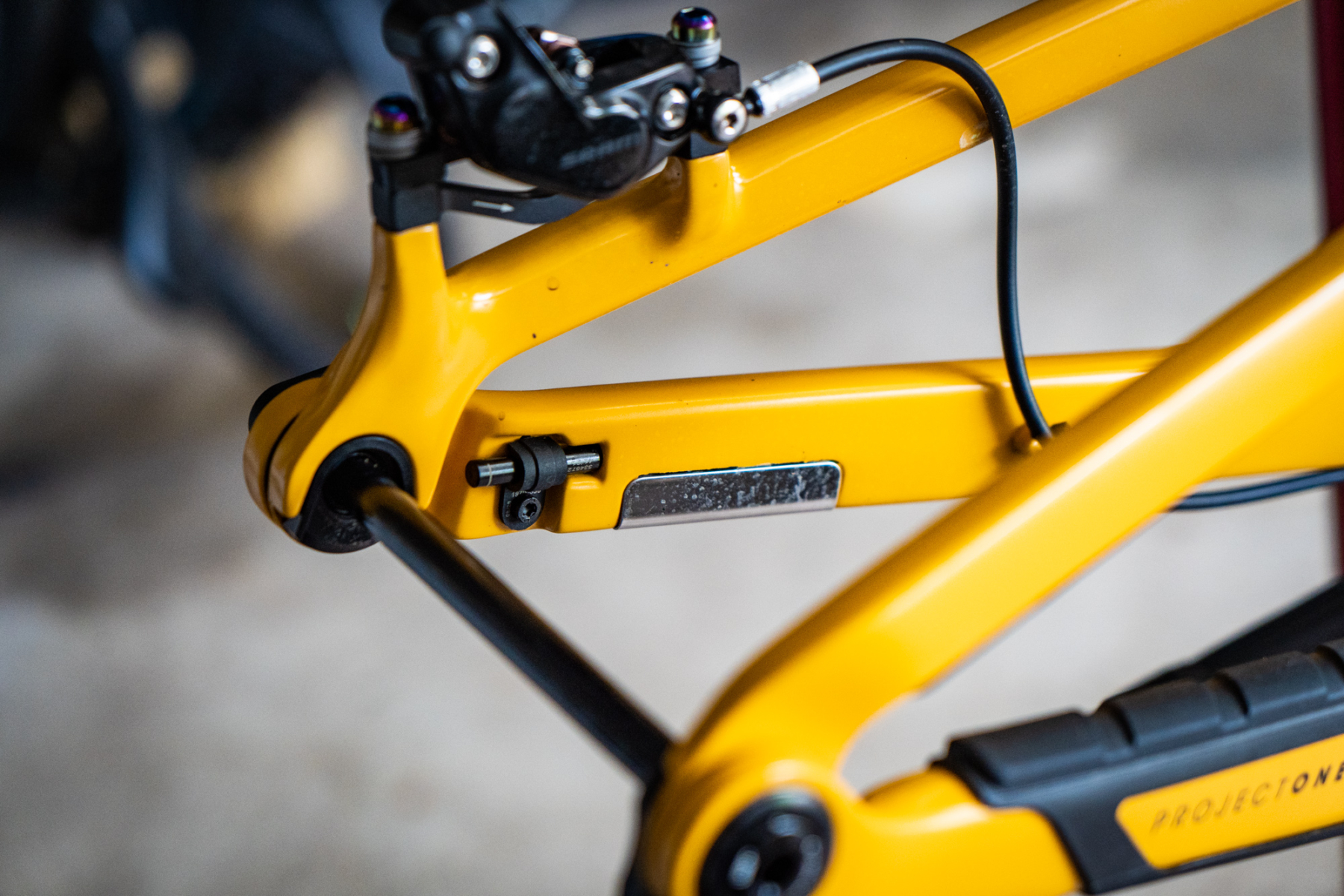
If you’re prepared to put in more effort at the pedals however, the mullet setup will be an effective way to add further agility into the Fuel EXe while increasing bum clearance for shorter riders. See our recent Specialized Stumpjumper mullet review if you’re keen to know more about the advantages and disadvantages.
Burlier tyres are a great upgrade
While the stock Bontrager SE5 tyres on the Trek Fuel EXe are decent all-rounders, we did find ourselves wishing for more bite up front. As well as wanting a stickier and more aggressive set of tyres, we were also curious to try out a slightly narrower width to improve handling precision.
Since reviewing the bike in its stock form, I’ve been riding the Fuel EXe with a set of Continental Kryptotal tyres. This combination features a front and rear specific tread pattern, and I elected for the burlier Enduro casing option that features the Soft rubber compound.
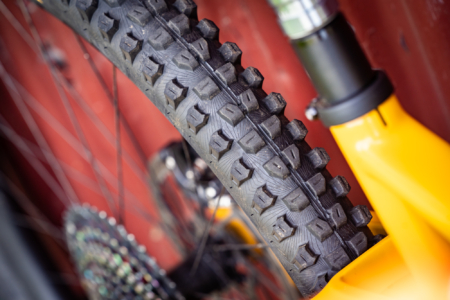
We’ll have a separate feature coming on the Continental tyre range, but so far I’ve been really impressed with this setup on the Fuel EXe. The 2.4in width suits the bike well, and the sturdy casings offer a really nice balance of stability and damping. Along with the soft rubber compound, the level of grip is outstanding, inspiring more confidence and control compared to the stock SE5s. Along with the 160mm fork up front, I’ve been able to push the Fuel EXe harder and faster on the descents, while enjoying a more responsive attitude through twisty singletrack.
Dialling in the contact points
As with the tyres, I’ve also been trying out some different contact points on our Trek Fuel EXe test bike. The stock Bontrager saddle and grips will be fine for most riders, but there’s always room for personalising these touch points to improve comfort and control.
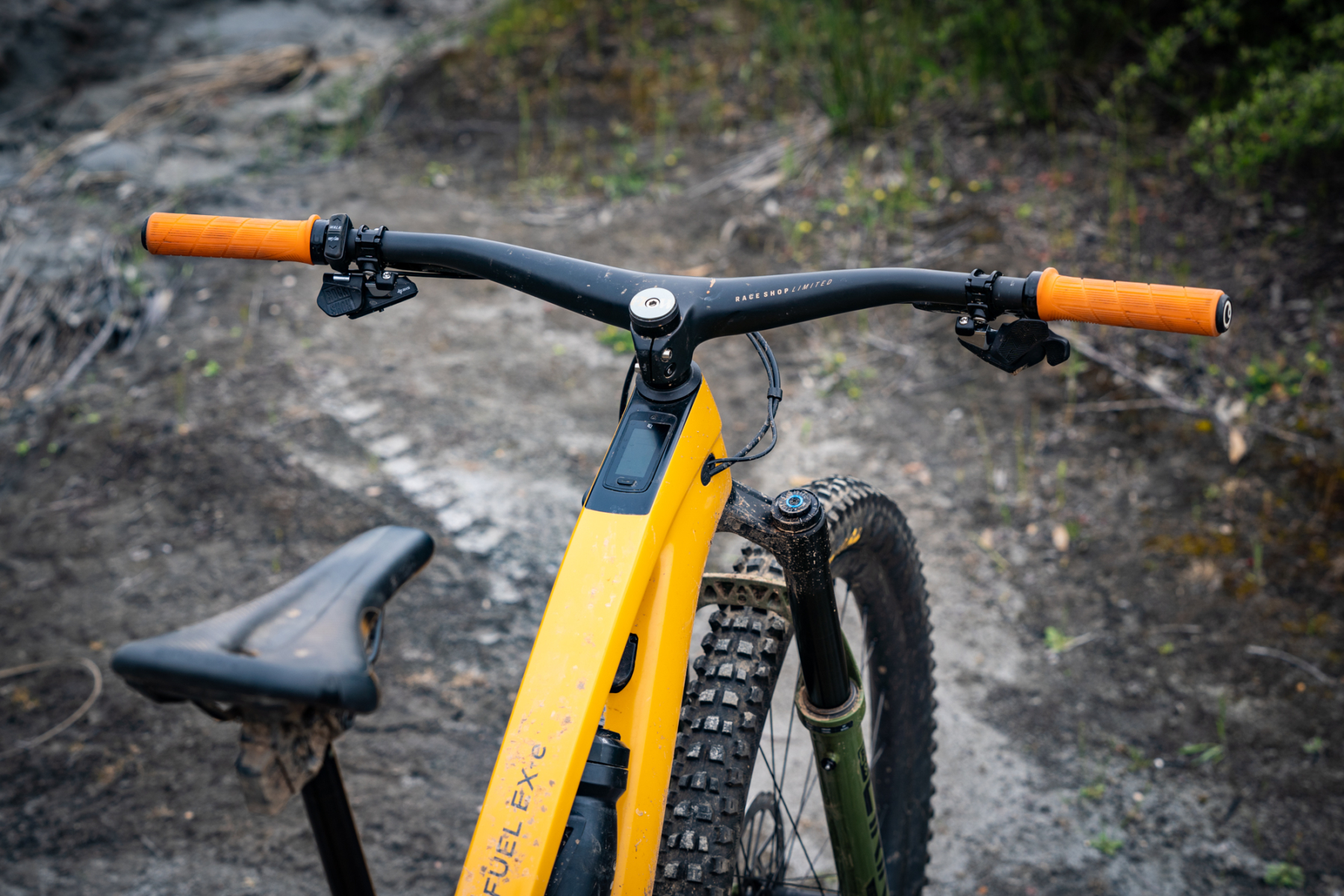
I swapped the Bontrager Arvada with an Ergon SM E-Mountain Pro saddle, which features a pronounced kick-tail profile. This elevated ramp at the end of the saddle is particularly beneficial on an e-MTB, as it helps to anchor your sit bones while you’re pedalling in the saddle on a steep climb. The ramp is subtle enough that it doesn’t feel weird on the flats though, and combined with the broad platform, relief channel and OthoCell inserts, this has quickly become my favourite e-MTB saddle.
Along with the saddle I’ve fitted a set of Ergon GD-1 grips. These utilise Ergon’s high-end Factory rubber compound, which is incredibly tacky while being quite durable. Along with the tapered profile and one-way traction grooves, the GD-1s provide a more tactile feel and much improved damping over the stock grips. A small but meaningful upgrade, which doesn’t cost a lot either.
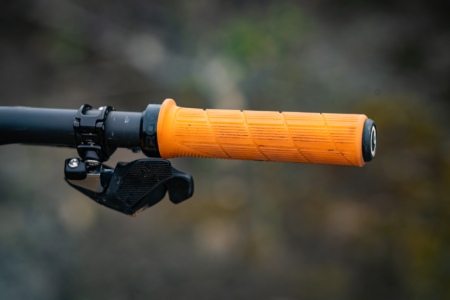
Flow’s Verdict
We continue to be impressed by the Trek Fuel EXe, which stands as one of the most agile and enjoyable electric mountain bikes we’ve ever ridden. The discreet TQ motor allows for elegant packaging, while offering quiet and subtle power delivery on the trail. And the option to tune the motor via the Trek Central app means you can customise its performance to suit your range requirements.
It’s also been great fun trying out different upgrades on our long-term test bike. The 160mm travel fork is a winner, offering a plusher and more controlled ride quality that allows you to capitalise on the Fuel EXe’s descending capabilities. Similarly, switching the stock tyres out for burlier casings and stickier rubber has levelled up traction and control. If you’re a Fuel EXe owner and you’re looking to broaden its performance window, we can highly recommend those upgrades.
Keen to know more about the tech and development behind the new bike, as well as prices and specs for the full range? Read on for our Trek Fuel EXe review .

Watch our Trek Fuel EXe video review here:
- Submit for Review
- Terms & Conditions
Enjoy reading this?
Get similar articles delivered directly to your inbox

IMAGES
VIDEO
COMMENTS
Trail mountain bikes. Fuel EX. Fuel EX is your go-to full suspension bike for doing it all every day. From epic big mountain rides on the weekend to rowdy local trails after work, Fuel EX is there for all your ups and downs. Choose from the lighter 130/140mm Fuel EX Gen 5 with better parts for the price or the more robust 140/150mm Fuel EX Gen ...
Fuel EXe is everything you've been craving on the singletrack. It's a full suspension e-mountain bike that flattens climbs and pushes you farther on every ride, without interrupting the way you experience the trail. It's your best trail ride ever, with extra Fuel in the tank. watch the walkthrough. Natural look.
Trek Fuel EX. Price: $7,700 (as tested) Buy from Trek Bikes. The Trek Fuel EX has always had a little more EXtra than the Top Fuel, and as the most recent Top Fuel rooted itself even deeper in the 120mm trail/XC department, Trek thickened the borders between the two. The sixth generation of the Trek Fuel EX gained 10mm of travel, with 140mm in ...
Brakes | Shimano SLX M7120 4-piston. Seatpost | Bontrager Line Elite Dropper Post, 170mm Travel. RRP | $6,999. Trek is making several Fuel EX 9.9 models, but the one coming into Australia for 2020 is this bike, which features Kashima-laden Fox suspension, carbon Bontrager wheels and SRAM X01 Eagle mechanical shifting.
In keeping with the new Trek Fuel EX's theme of being adaptable and capable. In its neutral-low setting, the bike comes with a 64.5-degree head tube angle and the effective seat tube angle sits at 77.2-degrees. Chainstays shift with the frame size, and on a large come in at 440mm. Thanks to the Mino Link flip chip, you can adjust bottom ...
The Fuel EX 8 is an impressively capable, versatile, and well-rounded trail bike that is ready for anything you are. Trek redesigned the Fuel EX models for the 2020 model year, updating the geometry and suspension design. This 29er still falls squarely in the mid-travel category with 130mm of rear suspension and a 140mm fork, but is more comfortable, capable, and confidence-inspiring than the ...
The new Gen 6, Fuel EX 9.8 is the burliest, most versatile, and most capable Fuel yet; truly up for whatever you want to ride. Trek completely redesigned Fuel EX models for 2023, updating the geometry and suspension while adding a ton of adjustability. The big wheel trail bike still falls squarely in the mid-travel category with 140mm of rear ...
An overview of the Trek Fuel EX 2023. For 2023, the Trek Fuel EX is built around an entirely new frame that's produced in carbon and alloy variants. Suspension travel has increased by 10mm at both ends, with the new Fuel EX now sporting a 150mm fork and 140mm of rear travel via the ABP four-bar suspension design.
At 14.89kg (32.83lb), the Trek Top Fuel 8 isn't that much lighter than a 150mm bike. So if you want one bike to conquer all trails, it wouldn't be our first choice. It's still a great 29er trail bike though, and if bike park laps and enduro racing don't fall under your trail bike remit, the Trek Top Fuel 8 offers a fast, fun and ...
There are nine 2023 Fuel EX models that start at $2,699.99 USD, but only eight of them are new bikes. That first price is for the EX 5 that's actually a carry-over using last year's aluminum frame ...
Breaking out into the emerging genre of lightweight e-MTBs is Trek's new sub-40 lb* Fuel EX-e. Rolling on dual 29" wheels, the EX-e touts 140mm of rear-wheel travel and a 150mm fork, just 10mm ...
Hitting the trails with Trek's top-of-the-line mountain e-bike, the Fuel EXe 9.9 XX1 AXS. Enlarge / The Fuel EXe 9.9 XX1 AXS. I rediscovered my bike after a few weeks in lockdown. At first, I just ...
Trek's successful Fuel design has been around for a few years, spawning longer-travel offshoots as well as high end cross-country race machines. The Fuel 70 is true to its roots, offering a modest ...
Trek Bicycle Corporation is a bicycle and cycling product manufacturer and distributor under brand names Trek, Electra Bicycle Company, Bontrager, and Diamant Bikes.The company has previously manufactured bikes under the Gary Fisher, LeMond Racing Cycles, Klein, and Villiger Bikes brand names.With its headquarters in Waterloo, Wisconsin, Trek bicycles are marketed [when?] through 1,700 ...
Trek's Fuel EX has been one of the best mountain bikes in the world for years, but the alloy-framed 8 is lacking some of the features the latest alloy and carbon Treks. High-durability component spec matches the vibe of a really well-balanced bike. One that plans ahead, hands its homework in early (having double checked it) and rarely puts a wheel wrong or goads you into being silly yourself.
Globally, there will be six Trek Fuel EXe models offered for 2023. Only three of those models will be available in Australia, with prices starting at $9,499 AUD for the Fuel EXe 9.5, and maxing out at $12,999 AUD for the Fuel EXe 9.8 XT. All Fuel EXe models make use of the same TQ-HPR50 motor, 360Wh battery and OCLV carbon frame.
Fuel EX 7 shines when you're charging down tricky descents, where the upgraded 130mm rear and 140mm front suspension package comes in handy. A sturdy aluminum frame, tubeless ready wheels, and a reliable 1x12 SRAM NX Eagle drivetrain make this an awesome all-around full suspension mountain bike. Compare. Color / Trek Black/Radioactive Red.
One last difference is frame material. Trek offers the Fuel EXe in six models, all with carbon fiber frames. The most affordable is the EXe 9.5, at $8,400. The Fuel EX, on the other hand, is ...
Warp drive. A warp drive or a drive enabling space warp is a fictional superluminal (faster than the speed of light) spacecraft propulsion system in many science fiction works, most notably Star Trek, [1] and a subject of ongoing physics research. The general concept of "warp drive" was introduced by John W. Campbell in his 1957 novel Islands ...
Price. $9,499 AUD - $12,999 AUD. Weight. 18.6kg. The Trek Fuel EXe was launched just a few months ago, arriving to much fanfare thanks to its unique TQ-HPR50 motor and clean aesthetics. We were totally captivated by the smooth and quiet motor performance, while the low weight, balanced geometry and supportive suspension gave it an impressively ...
In the Star Trek fictional universe, dilithium is an invented material that serves as a controlling agent in the matter-antimatter reactors. In the original series, dilithium crystals were rare and could not be replicated, making the search for them a recurring plot element.According to a periodic table shown during a Next Generation episode, it has the atomic number 87 (which in reality ...